| The Grateful Dead: "Aoxomoxoa"
(Warner, Juni 1969) |
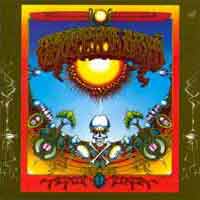 Der
dritte Streich meiner Helden, noch etwas unausgegoren, aber schon mit
einigen Klassesongs (z.B. "Saint Stephen" und "China Cat
Sunflower", fast alle Texte inzwischen von bandeigenen Lyriker Robert
Hunter und die Musik von Leadgitarrist Jerry Garcia mit gelegentlicher
Unterstützung von Bassist Phil Lesh), denn ihre psychedelischen
Exkursionen kamen erst live voll zur Geltung, weshalb wenige Monate später
auch das Live-Doppelalbum "Live/Dead"
erst den Durchbruch brachte. Im Studio gelangen die Bigpoints erst später
mit den Countryrockalben "Workingman's Dead"
und "American Beauty" von 1970. Der
dritte Streich meiner Helden, noch etwas unausgegoren, aber schon mit
einigen Klassesongs (z.B. "Saint Stephen" und "China Cat
Sunflower", fast alle Texte inzwischen von bandeigenen Lyriker Robert
Hunter und die Musik von Leadgitarrist Jerry Garcia mit gelegentlicher
Unterstützung von Bassist Phil Lesh), denn ihre psychedelischen
Exkursionen kamen erst live voll zur Geltung, weshalb wenige Monate später
auch das Live-Doppelalbum "Live/Dead"
erst den Durchbruch brachte. Im Studio gelangen die Bigpoints erst später
mit den Countryrockalben "Workingman's Dead"
und "American Beauty" von 1970. |
| The Grateful Dead: "Workingman's
Dead" (Warner Bros., Juni 1970) |
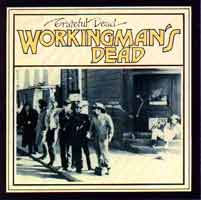 Sorgten sie noch im Jahr zuvor mit ihren Endlosjams (verdientermassen)
für Aufmerksamkeit ("Live/Dead"
von 1969), so glänzten sie im Jahr 1970 durch zwei wunderbare, songorientierte
Alben, die ihre Countrywurzeln deutlich werden liessen. Jerry Garcia
entdeckte die Pedalsteel und es erklingt mehrstimmiger Gesang á
la CSN&Y. Zahlreiche Dead-Klassiker finden sich auf diesem Album:
"Uncle John's Band", "Dire Wolf", "Cumberland
Blues", "Black Peter" und "Casey Jones".
Sorgten sie noch im Jahr zuvor mit ihren Endlosjams (verdientermassen)
für Aufmerksamkeit ("Live/Dead"
von 1969), so glänzten sie im Jahr 1970 durch zwei wunderbare, songorientierte
Alben, die ihre Countrywurzeln deutlich werden liessen. Jerry Garcia
entdeckte die Pedalsteel und es erklingt mehrstimmiger Gesang á
la CSN&Y. Zahlreiche Dead-Klassiker finden sich auf diesem Album:
"Uncle John's Band", "Dire Wolf", "Cumberland
Blues", "Black Peter" und "Casey Jones".

 Mehr ...
Mehr ...
The Grateful Dead were already established as paragons of the free-form, improvisational San Francisco psychedelic sound when they abruptly shifted gears for the acoustic Workingman's Dead, a lovely exploration of American roots music illuminating the group's country, blues, and folk influences. The lilting "Uncle John's Band," their first radio hit, opens the record and perfectly summarizes its subtle, spare beauty; complete with a new focus on more concise songs and tighter arrangements, the approach works brilliantly. Despite its sharp contrast to the epic live space jams on which the group's legend primarily rests, Workingman's Dead nonetheless spotlights the Dead at their most engaging, stripped of all excess to reveal the true essence of their craft.
(by Jason Ankeny , All Music Guide)
A radical and completely unexpected change in style - once and for all, the Dead suddenly cut short all the attempts to annihilate the differences between their live and studio sound and go off pursuing a more laid-back, mainstreamish country-rock direction. General musical philosophy usually ascribes this change of the Dead's musical philosophy to the passing of an era: the Altamont Massacre (which, by the way, was an event that had a deep impact on the band indeed - 'New Speedway Boogie' is sometimes said to be dedicated to the event) and the fade-away of the hippie ideology made them leave all their psycho jams for the live shows and concentrate on more concise, rational work in the studio.
That said, Workingman's Dead certainly doesn't deserve the 'classic' status so readily appended on it by most musical critics. It's a fairly good and enjoyable record, for sure, but by all objective means, there ain't that much special about it. The eight tracks on here more or less exploit the same two or three vibes (slow rambling acoustic country shuffle; mid-tempo mellow acoustic country boogie; mid- or fast-tempo soft electric country rocker), and the melodies aren't all that outstanding, either. And still, after repeated listens, I find myself liking this stuff much more than I really should, even considering my general subjective musical tastes which certainly aren't all that tolerant towards this kind of music.
In the end, I suppose this is due not to some kind of hidden magic (actually, I never believe in 'hidden magic' - leave that crap for Trout Mask Replica lovers), but rather to a number of small details, each of which is not too significant on its own, but taken altogether they make the record really work. There's Garcia's soulful, gentle, emotional voice that's very inviting. There's the lyrics, more often interesting and intriguing than not (by the way, the absolute majority of songs on here were penned by the Garcia-Hunter team). There's the fact that the melodies, while not being exceedingly catchy, are almost always a wee bit untrivial - it looks like the Dead were taking generic patterns and always taking care to make a few twists here and there so that they wouldn't turn out generic in the end, thus not only making the album sound more surprising, but also more personal. There's the sparse, economic instrumentation which always allows the listener to concentrate on one or two instruments (very well placed in the mix) and enjoy the fullness of their sound instead of just having to swallow the whole 'package' like some tasteless medicine. And finally, there's the playing, particularly Jerry's tasteful slide work.
I mean, sure, one could always object and say that Garcia's voice can get monotonous, the lyrics don't mean a lot, the melodies are unmemorable, the sparse instrumentation isn't varying all that much, and there were tons of more professional musicians whose slide work was far more tasteful than Garcia's. But like I said, it's the combination of all this that matters; simply put, this is one of the most carefully crafted roots rock records that I've ever heard, and the most amazing thing is, even with all that immaculate craftsmanship, it still does not sound slick and lifeless, like some generic sterile country recording.
Well, I suppose I just put all that lengthy analysis because I couldn't say all that much about the actual songs, could I? More or less so. Okay, first of all, despite all the praise, I could still easily live without the two slow acoustic shuffles, each on one side ('High Time' and 'Black Peter', two excellent cures for insomnia, although nowhere near as appalling as 'Attics Of My Life' on the next record). I'm also not terribly impressed by the album opener, 'Uncle John's Band', even it does have a nice, intimate vibe about it and went on to become one of the band's stage favourites.
But the rest is good. The faster songs boogie along and make you tap your foot and revel in their subtle malevolence, particularly 'New Speedway Boogie' which is quite malevolent indeed; and the guitar interplay on 'Cumberland Blues' really gets me going as well. 'Easy Wind' overdoes the chaotic jamming section at the end a bit, but at least it's not that chaotic jamming that we usually associate with the Dead; otherwise, it's another good mid-tempo rocker. But the real highlights of the album are, without a doubt, 'Dire Wolf' and 'Casey Jones'. 'Dire Wolf', in fact, gives me the creeps - it's structured as a pleasant, laid-back soft country rocker with homely slide guitar homely sliding in the background, but the chorus? 'Don't murder me, I beg you, you don't murder me, please don't murder me', sung in Garcia's nicest tone ever. Woof, pretty scary, and a worthy predecessor to the even more grappling 'Friend Of The Devil' on American Beauty. And 'Casey Jones'? It tells the story of an engineer who's driving a train "under intoxication" and gets into a lethal accident, but that would be hard to guess from the playful, 'lightweight' melody (the catchiest refrain on the album, for sure). Imagine that.
Of course, their next album would seriously build on this foundation, with the Dead somewhat expanding their territory and drawing on more styles and moods, so anybody looking for this band's "studio wonders" should first look up American Beauty. But no fans of American Beauty will ever be disappointed in Workingman's Dead, that's for sure.
(by George Starostin, Only Solitaire)
|
| The Grateful Dead: "American
Beauty" (Warner, Sept. 1970) |
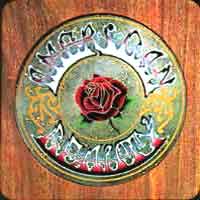 Kurz nach "Working Man's Dead" der
zweite Geniestreich der Dead, diesmal mit "Friend Of The Devil",
"Box Of Rain" (Phil Lesh singt!), "Sugar Magnolia",
"Candyman", "Ripple" und "Truckin'". Letzter
Titel kam dem am nächsten, was man bei den Dead einen Singlehit nennen
könnte.
Kurz nach "Working Man's Dead" der
zweite Geniestreich der Dead, diesmal mit "Friend Of The Devil",
"Box Of Rain" (Phil Lesh singt!), "Sugar Magnolia",
"Candyman", "Ripple" und "Truckin'". Letzter
Titel kam dem am nächsten, was man bei den Dead einen Singlehit nennen
könnte.

 Mehr ...
Mehr ...
| The Dead were never better in the studio than on the down-home
stoner country of American Beauty. Released just six months after the folkie
classic Workingman's Dead, Beauty has some of the band's most beloved songs,
including "Box of Rain" and "Friend of the Devil." (Rolling
Stone)
Total album sales: 2 million + Peak chart position: 30
|
|
| "Time flies but some things prevail. The Grateful
Dead recorded and released American Beauty in 1970. What a brilliant name
for a brilliant record! The original Dead line-up deep in Americana. Country
music with an acid twist. Some really beautiful songs: Box Of Rain, Friend
Of The Devil, Candyman, to name but three. Some really beautiful steel guitar
by Jerry Garcia. And the vocals, coached by CS&N, are the best I've
heard from The Dead. I really can't say anything bad about this record."
|
|
|
"Who says discipline is a bad thing? No one who's heard American
Beauty, the Dead's greatest studio achievement. Showcasing 10 concise,
country-rooted gems that sound equally good whether you're hanging on
the front porch in the afternoon or nursing a bottle after hours, this
one could win over many an anti-Jerry. Bewildered by loss both personal
and social--the hippie dream was quickly crashing by Beauty's 1970 release
date--the band put its querulousness ("Box of Rain") and wry
humor ("Truckin'") into the service of a masterwork. The most
impressive cut of all may be "Ripple," Garcia's spiritual credo."
(Rickey Wright)
|
|
|
A companion piece to the luminous Workingman's Dead, American Beauty
is an even stronger document of the Grateful Dead's return to their musical
roots. Sporting a more full-bodied and intricate sound than its predecessor
thanks to the addition of subtle electric textures, the record is also
more representative of the group as a collective unit, allowing for stunning
contributions from Phil Lesh (the poignant opener "Box of Rain")
and Bob Weir ("Sugar Magnolia"); at the top of his game as well
is Jerry Garcia, who delivers the superb "Friend of the Devil,"
"Candyman," and "Ripple." Climaxing with the perennial
"Truckin'," American Beauty remains the Dead's studio masterpiece
-- never again would they be so musically focused or so emotionally direct.
(by Jason Ankeny, All
Music Guide)
|
|
|
Indeed. What an appropriate title for a record that takes some of the
eldest, bearded, most respectable American musical styles, strips them
bare of everything that witty rock musicians have invented in the past
two or three years and presents in their 'naked beauty'. On first listen,
I hated this album. 'I can't believe it!' I was saying to myself. 'They
call it a classic? This dead-ly bore with not a single original or memorable
melody in sight?' But of course, this turned out to be one of those cunning
records that are not melody-oriented at all, or at least, not hook-oriented...
Like Workingman's Dead, this record presents the Grateful Dead as a folk/country
band, with no traces of a spaced-out jam anywhere in sight; unlike Workingman's
Dead, though, the album is somewhat more diverse and the songs are somewhat
more edgy, which is why most fans of the two records prefer the second
one over the first one. There's just about, like, totally nothing revolutionary
or revelatory about this album - all of this stuff was already done by
the Byrds (whose output many of the numbers painfully recall, especially
the more 'harmonized' ones) and other, less significant folk-rock bands
before. However, once you take a somewhat deeper insight (and take a couple
more listens, which also won't hurt), you'll discover that this style
has little in common with the Byrds, harmonies excepted. In fact, the
'harmonized' numbers are eventually the worst on record - like the dreadful
'Attics Of My Life', a super-slow, lethargic lullaby that'll put a zombie
back in the ground in a second's time. Of course, it's probably a fan
favourite, but I've already offended so many fans' favourites on this
site that one more will have little effect on the death sentence already
carried out... But hey, my commentators tend to agree with me on that
one, so at least I don't feel alone and deserted.
The biggest difference is, of course, that the Dead use their typical
guitar sound that bears no resemblance to McGuinn's patented '12-string
jangle'. Jerry Garcia and Bob Weir use their instruments with mastership
- and, in this case, quite economically. Tasteful guitar licks abound
- like the riff that holds together the pretty, fast-paced folkish ditty
'Sugar Magnolia', or the R'n'B elements on 'Truckin'. The production is
also much more 'thin' than the Byrds' one, and the material is thus somewhat
more 'accessible' - sometimes it sounds like the band are just having
a groovy time in your living-room. And, of course, harmonies or no harmonies,
the boys always do a great singing job each on his own (I'm just not a
fan of singing in unison!).
Now the material here is really uneven, which is still my main complaint.
Yet this is also an advantage - see, while the style of this record was
never invented by the members of the Dead themselves, the actual melodies
on here are hardly ripped-off: I hear plenty of ideas that I'd never heard
before. I mean, I can often accuse Dylan of stealing folk melodies and
passing them for his own, but I really couldn't say the same about the
Dead. These songs, in contrast to the general marking 'traditional, arranged
by so-and-so', should all be tagged: 'traditionally arranged, by the Grateful
Dead' (now do you see the improtance of commas?).
So yeah, there are some hit and miss moments on the album, but that's
gotta be forgiven. Like I said, 'Attics Of My Life' is a horrendous song,
and I'll probably never change my opinion about that one. 'I-i-i-i-i-n
the a-a-a-a-a-a-a-ttics o-o-o-o-o-f my-y-y-y-y-y li-i-i-i-i-i-ife...',
boy, I feel this coma coming on again. Let's change subject and speak
of Garcia's 'Friend Of The Devil', the song I like the most on here because
it's probably your best bet for a heart-wrenching pessimistic ballad on
the album, you know, of the type 'got-that-hound-on-my-trail-gotta-run-afore-it's-too-late'
kinda stuff. It's got some great countryish guitar, too, but my main compliments
are directed at the singing and lyrics. Out of the sad, whiny numbers
there's also the opening 'Box Of Rain', a great multi-guitar song where,
for once, the harmonies sound really really good. The message is a little
unclear, although, but I don't mind.
Out of the fast numbers you're probably sure to know 'Truckin', with its
great instrumentation and telling lyrics about the band's touring schedule
and their, well, disappointment in True Love (a subject common in 1970,
but to hear lines like 'Most of the cats you meet on the street speak
of True Love/Most of the time they're sitting and crying at home' in a
Grateful Dead is a little like hearing Richard Nixon advising American
kids to drop out). 'What a long strange trip it's been' indeed. It also
strikes you as pretty upbeat and even 'raving' as compared to the quiet
atmosphere of the album - and the vocal melody style is definitely ripped-off
of Chuck Berry's numbers such as 'No Particular Place To Go', with just
a wee bit of speeding up. But I guess that's a conscious rip-off: after
all, it was only natural for the band to end this 'roots tribute' with
a Fifties' boogie sendup.
But if that's all you know from this record, don't you miss the already
mentioned 'Sugar Magnolia' with that cool guitar riff, nor 'Operator',
a sly slide-driven number with particularly 'attractive' (yeah, right)
vocals by Pigpen, the harmonica player. Finally, I've even overcome myself
to appreciate 'Candyman', a number that recalls Bob Dylan circa 1962:
a lengthy, drooning folk number that nevertheless sounds inviting and
very disposing - where 'Attics Of My Life' just invites you to lean on
your pillow, 'Candyman' really invites you to lightly tap your foot and
rock to and fro in harmony with the melody.
So, as you see, apart from the wretched 'Attics' and a couple of other
minor misfires, I pretty much manage to dig this record. I almost find
this strange, because I never really usually dig 'hardcore Americano'
records (hell, I even expressed my displeasure towards Willy And The Poorboys),
and yet, this album is likable for me, even if I can't name any original
ideas on here. I guess I ought to put the blame on the band's high-heeled
professionalism and, well, taste: sure, I know that accusing the Dead
of having taste is pretty much an oxymoron, but what can one do if one
is put in front of inescapable facts? Go buy this record and put it next
to the American flag if you keep one in your house. Well, I don't suppose
it's called American Beauty for nothing - here's a title that matches
an album's content as perfectly as it ever gets.
(by George Starostin,
Only Solitaire)
|
|
| Jerry Garcia: "Garcia
(The Wheel)" (Warner Bros., Jan. 1972) |
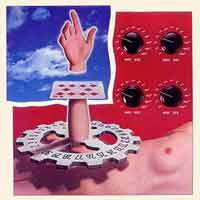 Diese
Platte hat Jerry (fast) alleine aufgenommen, er wurde nur vom Dead-Trommler
Bill Kreutzmann unterstützt. Enthält neben einigen Soundexperimenten
ein paar tolle Songs, die schnell den Weg in das Bühnenrepertoire
der Dead fanden: "Deal", "Birdsong", "Sugaree",
"Loser", "To Lay Me Down" und "The Wheel". Diese
Platte hat Jerry (fast) alleine aufgenommen, er wurde nur vom Dead-Trommler
Bill Kreutzmann unterstützt. Enthält neben einigen Soundexperimenten
ein paar tolle Songs, die schnell den Weg in das Bühnenrepertoire
der Dead fanden: "Deal", "Birdsong", "Sugaree",
"Loser", "To Lay Me Down" und "The Wheel". |
| Bob Weir: "Ace" (Warner,
Mai 1972) |
|
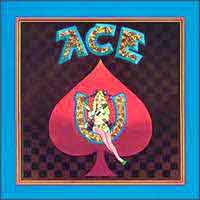 Bob
Weirs Solodebut ist ein verkapptes Grateful Dead - Album, denn er wird
hier durchgängig von seiner Stammband begleitet (Jerry Garcia,
Phil Lesh, Bill Kreutzmann und der Neuzugang Keith
Godchaux). Zum ersten Mal tritt auch Donna Godchaux in Erscheinung,
die danach ebenfalls festes Bandmitglied wurde. Die meisten der Songs
fanden danach auch den Weg in das Dead-Repertoire: "Greatest Story
Ever Told", "Playing In The Band", "Looks Like Rain",
"Cassidy" und "One More Saturday Night". Eines der
besten Dead-Alben, nur eben ohne Garcia-Songs und Garcia-Gesang. Bob
Weirs Solodebut ist ein verkapptes Grateful Dead - Album, denn er wird
hier durchgängig von seiner Stammband begleitet (Jerry Garcia,
Phil Lesh, Bill Kreutzmann und der Neuzugang Keith
Godchaux). Zum ersten Mal tritt auch Donna Godchaux in Erscheinung,
die danach ebenfalls festes Bandmitglied wurde. Die meisten der Songs
fanden danach auch den Weg in das Dead-Repertoire: "Greatest Story
Ever Told", "Playing In The Band", "Looks Like Rain",
"Cassidy" und "One More Saturday Night". Eines der
besten Dead-Alben, nur eben ohne Garcia-Songs und Garcia-Gesang.
"Notes: I've always thought of this album as the
record that launched a thousand tatoos. With a band made up of a large
portion of the Grateful Dead, Weir make this his own album. The tunes
from these sessions became standards during live performances. Either
live or in the studio tunes like "Looks Like Rain" will always
make me stop what I'm doing and listen for a bit. And the cover colors
are bright, but still produce a nice quiet effect."
|
| Mickey Hart: "Rolling
Thunder" (Warner, Sept. 1972) |
|
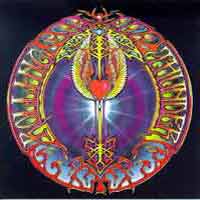 "Rolling
Thunder", das Solodebüt des zu diesem Zeitpunkt ehemaligen
Grateful Dead-Schlagzeugers (er kehrte 1976 zur Band zurück), wurde
etwa zeitgleich mit Bob Weir's Solodebüt "Ace"
aufgenommen. Zwei Songs gibt es auf beiden LPs, wenn auch mit unterschiedlichen
Namen: "Rolling
Thunder", das Solodebüt des zu diesem Zeitpunkt ehemaligen
Grateful Dead-Schlagzeugers (er kehrte 1976 zur Band zurück), wurde
etwa zeitgleich mit Bob Weir's Solodebüt "Ace"
aufgenommen. Zwei Songs gibt es auf beiden LPs, wenn auch mit unterschiedlichen
Namen:
"The Main Ten" ist zum Teil eine Version von "Playing
In The Band", das auch schon auf dem letztjährigen Livealbum
der Dead erschien. "Pump song" wurde zu "Greatest Story
Ever Told". Dieser Song, so Bob Weir, "actually
started out with a pump Mickey had - he recorded the pump and told me
to write a song."
Die Besetzungsliste versammelt das "Who Is Who" der damaligen
San Francisco-Szene: Bob Weir, Jerry Garcia und Phil
Lesh von den Dead, John Cipollina von Quicksilver Messenger
Service, Paul Kantner, Grace Slick und David Freiberg
von Jefferson Airplane, Sam Andrew von Big Brother & The
Holding Conmpany, Barry Melton von Country Joe & The Fish,
sowie Stephen Stills und Zakir Hussain.
"...Mickey Hart's album "ROLLING THUNDER"
is finally finished after a year and a half's work and is due to be
released in the first part of September. It features Mickey as well
as at least thirty of the heaviest musicians around these days . . .
really a fine album!" (3rd Deadheads newsletter, August 1972)
|
| Grateful Dead: "Wake Of
The Flood" (Grateful Dead, Sept. 1973) |
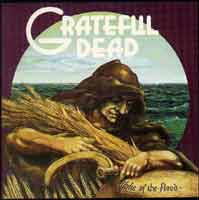 Die
erste Veröffentlichung auf dem bandeigenen Plattenlabel - eine wunderbare
Platte (ich bin als verkappter "Deadhead" da aber wohl nicht
besonders objektiv). Deshalb hier nur ein paar Fakten: die erste Platte
nach dem Tod von Pigpen und auch die erste Studioproduktion mit
dem neuen Keyboarder Keith Godchaux, der hier auch zum ersten und
einzigen mal in seiner Deadzeit singt ("Let Me Sing Your Blues Away").
Ebenfalls neu dabei seine Frau Donna Jean Godchaux als Chorsängerin
(sie tritt aber kaum in Erscheinung und war wegen ihrer Rolle in der Band
auch immer ein Diskussionspunkt für Fans). Von Jerry Garcia
gibt es mehrere gute Songs ("Half-Step Missisppi...", "Stella
Blue" und "Row Jimmy"), nur die Single "Eyes Of The
World" ist nach meiner Geschmack etwas schwächer. Von Bob
Weir hören wir eine mehrteilige "Weather Report Suite",
Bill Kreutzmann muss z. Z. ohne seinen Trommelpartner Mickey
Hart auskommen, Phil Lesh ist am Bass wie immer genial, aber
mal wieder ohne eigene Songs und Gesangsversuche. Ungewöhnlich ist
die große Anzahl von Gastmusikern (Doug Sahm, Matt Kelly,
Vassar Clements, Martin Fierro u.a.). Das Album wurde übrigens
von der Band Jazz Is Dead komplett gecovert ("Laughing
Water", Zebra 1999)! Die
erste Veröffentlichung auf dem bandeigenen Plattenlabel - eine wunderbare
Platte (ich bin als verkappter "Deadhead" da aber wohl nicht
besonders objektiv). Deshalb hier nur ein paar Fakten: die erste Platte
nach dem Tod von Pigpen und auch die erste Studioproduktion mit
dem neuen Keyboarder Keith Godchaux, der hier auch zum ersten und
einzigen mal in seiner Deadzeit singt ("Let Me Sing Your Blues Away").
Ebenfalls neu dabei seine Frau Donna Jean Godchaux als Chorsängerin
(sie tritt aber kaum in Erscheinung und war wegen ihrer Rolle in der Band
auch immer ein Diskussionspunkt für Fans). Von Jerry Garcia
gibt es mehrere gute Songs ("Half-Step Missisppi...", "Stella
Blue" und "Row Jimmy"), nur die Single "Eyes Of The
World" ist nach meiner Geschmack etwas schwächer. Von Bob
Weir hören wir eine mehrteilige "Weather Report Suite",
Bill Kreutzmann muss z. Z. ohne seinen Trommelpartner Mickey
Hart auskommen, Phil Lesh ist am Bass wie immer genial, aber
mal wieder ohne eigene Songs und Gesangsversuche. Ungewöhnlich ist
die große Anzahl von Gastmusikern (Doug Sahm, Matt Kelly,
Vassar Clements, Martin Fierro u.a.). Das Album wurde übrigens
von der Band Jazz Is Dead komplett gecovert ("Laughing
Water", Zebra 1999)! |
| The Grateful Dead: "From
The Mars Hotel" (Grateful Dead Rec., Juni 1974) |
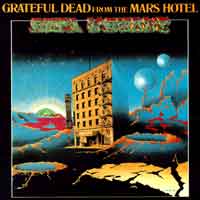 Nicht
mein Lieblinxalbum der Band, aber eigentlich doch ganz schön! Kleine
Besonderheit: es gibt gleich zwei vom Bassisten Phil Lesh komponierte
und gesungene Lieder ("Unbroken Chain" mit Synthesizereinlagen
von Lesh-Spezie Ned Lagin und der bizarre Countrysong "Pride
Of Cucamonga" mit der Pedalsteel des Doobie Brothers John McFee). Nicht
mein Lieblinxalbum der Band, aber eigentlich doch ganz schön! Kleine
Besonderheit: es gibt gleich zwei vom Bassisten Phil Lesh komponierte
und gesungene Lieder ("Unbroken Chain" mit Synthesizereinlagen
von Lesh-Spezie Ned Lagin und der bizarre Countrysong "Pride
Of Cucamonga" mit der Pedalsteel des Doobie Brothers John McFee).
Zwei Garcia-Beiträge sind sehr gelungen: "Ship Of Fools"
und "China Doll", zwei weitere dagegen eher nicht, weil für
meinen Geschmack zu plump rockend ("U.S. Blues" und "Loose
Lucy"). Der einzige Beitrag von Bob Weir ("Money Money")
fällt leider auch in die letzte Kategorie. |
| Robert Hunter: "Tiger Rose"
(Round, März 1975) |
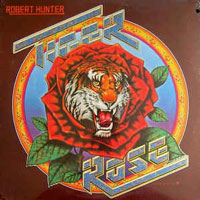

 Mehr ...
Mehr ...
Robert Hunter's Grateful Dead writing partner Jerry Garcia took a major role on his second album, producing and arranging the songs and playing guitar. The result was a more consistent, listenable album than Hunter's debut, Tales Of The Great Rum Runners. Hunter sang in a somewhat more natural, assured voice on these mostly country-flavored tracks that sometimes recalled the Dead's Workingmans Dead and American Beauty albums, though he continued to strain to reach high notes. As usual, the imagery in Hunter's lyrics was rich and poetic, with a Western tone. (Despite the improvement in his singing, Hunter took the occasion of a Rykodisc reissue of Tiger Rose in 1988 to record new vocals over the instrumental tracks. Released in 1989, this version of the album is reviewed separately.)
(by William Ruhlmann, All Music Guide)
|
| Grateful Dead: "Blues
For Allah" (Grateful Dead, Sept. 1975) |
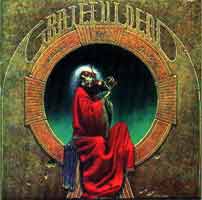 Für
manche ist das die beste Dead-Platte. Zumindest die beste von den Studioplatten.
Nach dem finanziellen Fiasko mit ihrem P.A.-System, dem mittelmäßigen
Album "From The Mars Hotel" und dem
schwachen Filmsoundtrack "Steal Your Face" schafften sie es
zum ersten Mal, ihre jazzige/improvisierende Seite im Studio angemessen
zu präsentieren. Außerdem war der verlorene Sohn Mickey Hart
endlich zurückgekehrt. Für
manche ist das die beste Dead-Platte. Zumindest die beste von den Studioplatten.
Nach dem finanziellen Fiasko mit ihrem P.A.-System, dem mittelmäßigen
Album "From The Mars Hotel" und dem
schwachen Filmsoundtrack "Steal Your Face" schafften sie es
zum ersten Mal, ihre jazzige/improvisierende Seite im Studio angemessen
zu präsentieren. Außerdem war der verlorene Sohn Mickey Hart
endlich zurückgekehrt.
Das ganze Album wurde übrigens von dem New Yorker Bassisten Joe
Gallant mit seiner Big Band Illuminati gecovert! |
| Jerry Garcia: "Reflections"
(Round, Feb. 1976) |
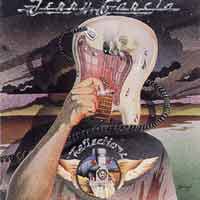 Jerrys drittes Soloalbum, zur Hälfte mit Grateful
Dead, zur hälfte mit seiner eigenen Band (John Kahn, Nicky
Hopkins und Ron Tutt) eingespielt. Ein paar schöne eigene Songs
(ich mag besonders "Comes A Time"), aber auch ein paar sehr
schöne Coversongs (z.B. das entschleunigte und zum Reggae umgebaute Bluegrassstück
"Catfish John" und das wunderbare "On Your Way Down"
von Allen Toussaint). Das Album ist um Klassen besser als sein
Ruf in der Deadhead-Gemeinde.
Jerrys drittes Soloalbum, zur Hälfte mit Grateful
Dead, zur hälfte mit seiner eigenen Band (John Kahn, Nicky
Hopkins und Ron Tutt) eingespielt. Ein paar schöne eigene Songs
(ich mag besonders "Comes A Time"), aber auch ein paar sehr
schöne Coversongs (z.B. das entschleunigte und zum Reggae umgebaute Bluegrassstück
"Catfish John" und das wunderbare "On Your Way Down"
von Allen Toussaint). Das Album ist um Klassen besser als sein
Ruf in der Deadhead-Gemeinde.

 Mehr ...
Mehr ...
| The third solo album from Grateful Dead lead guitarist Jerry
Garcia comes as the result of the band's mini-hiatus from touring during
late 1974 and most of 1975. Rather than auditioning a new combo, Garcia
splits Reflections evenly between recordings made with the Dead as well
as his Legion of Mary and Jerry Garcia Band side projects. As with his previous
non-Dead effort, Garcia (Compliments of Garcia), this disc includes a blend
of originals and cover tunes. Astute Deadheads will inevitably recognize
that all four cuts featuring backing by the Dead had been part of their
live repertoire for several years. Although only five of the tracks were
co-authored by Garcia's primary lyrical collaborator, Robert Hunter, all
eight of them remained in Garcia's solo set lists for the balance of his
career. The material on this album is uniformly strong and includes some
of the best studio work that the Dead had been involved in since American
Beauty and Workingman's Dead. Their sound is no longer as rurally influenced;
instead, they adopt an equally laid-back, jazzy approach. This is perhaps
most strikingly evident in the new direction given to "They Love Each
Other." Although initially presented as an up-tempo boogie, by contrast
it is now a slinky, low-key affair. The retooled version became a staple
throughout the Dead's mid-to-late-'70s live sets, occasionally resurfacing
during their waning years. There are more subtle variations on the absolutely
stunning and emotive ballads "Comes a Time" and "Must Have
Been the Roses" -- which also cropped up underneath the closing credits
of the Grateful Dead Movie (1976).
The all-star cast that Garcia assembled for "Mission in the Rain"
-- as well as Allen Toussaint's "I'll Take a Melody," Hank Ballard's
"Tore up Over You," and the Johnny Russell country hit "Catfish
John" -- includes John Kahn (bass), Ron Tutt (drums), Nicky Hopkins
(keyboards), and Larry Knechtel (keyboards). The latter cover tune is
also notable, as both Garcia and Kahn had presented it with a full-throttle
bluegrass attitude during their time in the short-lived Old & in the
Way project. With the exception of Knechtel, the remaining trio continued
to perform in the Jerry Garcia Band during the mid-'70s. -- Lindsay Planer
(AMG)
|
|
| Grateful Dead: "Terrapin
Station" (Arista, Juli 1977) |
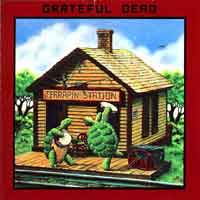 Nachdem ihr eigenes Label finanzielle Probleme bekam, unterschrieben die
Dead zum zweiten Mal bei einer Major-Company. Clive Davis, der
in den 60ern die Band gerne für seinen damaligen Arbeitgeber CBS
verpflichtet hätte, war inzwischen Chef im eigenen Laden Arista.
Erstmals seit "Anthem Of The Sun" (1968) gab es mit Keith
Olsen, der gerade mit Fleetwood Mac's "Rumours"
einen gigantischen Erfolg feierte, auch einen externen Produzenten. Der
Aufschrei war dann groß: MAINSTREAM! SCHRECKLICH! Kurioserweise wurde
"Terrapin Station" dann aber eher das "Progrock-Album"
der Band, was vielleicht am Titelsong liegt, der die ganze B-Seite einnimmt
und mit Orchester- und Choreinsätzen daherkommt. Dabei übersieht
man die guten Songs der A-Seite: Bob Weir's "Estimated Prophet"
ist ein genialer Reggae im 7/4-Takt, "Passenger" der erste Phil
Lesh-Song seit Mars-Hotel-Zeiten, "Sunrise"
das einzige Dead-Stück, das von Donna Godchaux gesungen und
komponiert wurde: hat natürlich nix mit echtem "Dead-Sound"
zu tun, ist aber eine schöne, vielleicht einen "Tacken"
zu kitschig-bombastische, Ballade.
Nachdem ihr eigenes Label finanzielle Probleme bekam, unterschrieben die
Dead zum zweiten Mal bei einer Major-Company. Clive Davis, der
in den 60ern die Band gerne für seinen damaligen Arbeitgeber CBS
verpflichtet hätte, war inzwischen Chef im eigenen Laden Arista.
Erstmals seit "Anthem Of The Sun" (1968) gab es mit Keith
Olsen, der gerade mit Fleetwood Mac's "Rumours"
einen gigantischen Erfolg feierte, auch einen externen Produzenten. Der
Aufschrei war dann groß: MAINSTREAM! SCHRECKLICH! Kurioserweise wurde
"Terrapin Station" dann aber eher das "Progrock-Album"
der Band, was vielleicht am Titelsong liegt, der die ganze B-Seite einnimmt
und mit Orchester- und Choreinsätzen daherkommt. Dabei übersieht
man die guten Songs der A-Seite: Bob Weir's "Estimated Prophet"
ist ein genialer Reggae im 7/4-Takt, "Passenger" der erste Phil
Lesh-Song seit Mars-Hotel-Zeiten, "Sunrise"
das einzige Dead-Stück, das von Donna Godchaux gesungen und
komponiert wurde: hat natürlich nix mit echtem "Dead-Sound"
zu tun, ist aber eine schöne, vielleicht einen "Tacken"
zu kitschig-bombastische, Ballade. |
| Jerry Garcia Band: "Cats Under
The Stars" (Arista, April 1978) |
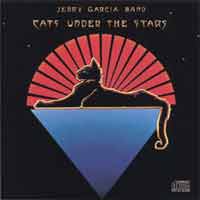 Ich habe vor kurzem den teuersten CD-Kauf meines Lebens gemacht, nämlich
die 6-CD-Box "All Good Things - Jerry Garcia Studio Session"
mit allen 5 Solowerken (ohne die zahlreichen Livealben), alle mit zahlreichen
Bonustracks und sogar einer 6. CD mit noch viel mehr. "Cats Under
The Stars" war die Nummer 4 und stand (natürlich) als Vinyl
schon lange im Plattenschrank, wenn auch ewig nicht mehr gehört.
Während die ersten drei Alben ("Garcia"
von 1972, "Garcia" von 1974
- Ihr merkt: Jerry kümmerte sich wenig um Marketing und Plattentitel
-, sowie "Reflections" von 1976)
bereits 1989 von Line-Records auf CD wiederveröffentlicht wurden
und auch viel von mir gehört wurden blieben die beiden Arista-Alben
(1982 kam noch das schwächere "Run For The Roses" raus)
aber irgendwie aus meinem Gedächtnis verschwunden. Jetzt läuft also
seit langer Zeit mal wieder "Cats Under The Stars", während
ich im Begleitbuch schmökere, und muss feststellen: es ist tatsächlich
das beste JGB-Album: alles klasse neue eigene Lieder (von Garcia, Bassist
John Kahn und Sängerin Donna Godchaux), die Band spielt
ausgezeichnet (Donna hat wirklich schöne Gesangsauftritte, Ex-Elvis-Drummer
Ron Tutt ist in Höchstform). Das Ganze hat eine eigentümlich
mystische Stimmung (kann ich nicht besser beschreiben), ganz anders als
bei den Dead, mit denen er fast Zeitgleich das Album "Shakedown Street"
herausbrachte.
Ich habe vor kurzem den teuersten CD-Kauf meines Lebens gemacht, nämlich
die 6-CD-Box "All Good Things - Jerry Garcia Studio Session"
mit allen 5 Solowerken (ohne die zahlreichen Livealben), alle mit zahlreichen
Bonustracks und sogar einer 6. CD mit noch viel mehr. "Cats Under
The Stars" war die Nummer 4 und stand (natürlich) als Vinyl
schon lange im Plattenschrank, wenn auch ewig nicht mehr gehört.
Während die ersten drei Alben ("Garcia"
von 1972, "Garcia" von 1974
- Ihr merkt: Jerry kümmerte sich wenig um Marketing und Plattentitel
-, sowie "Reflections" von 1976)
bereits 1989 von Line-Records auf CD wiederveröffentlicht wurden
und auch viel von mir gehört wurden blieben die beiden Arista-Alben
(1982 kam noch das schwächere "Run For The Roses" raus)
aber irgendwie aus meinem Gedächtnis verschwunden. Jetzt läuft also
seit langer Zeit mal wieder "Cats Under The Stars", während
ich im Begleitbuch schmökere, und muss feststellen: es ist tatsächlich
das beste JGB-Album: alles klasse neue eigene Lieder (von Garcia, Bassist
John Kahn und Sängerin Donna Godchaux), die Band spielt
ausgezeichnet (Donna hat wirklich schöne Gesangsauftritte, Ex-Elvis-Drummer
Ron Tutt ist in Höchstform). Das Ganze hat eine eigentümlich
mystische Stimmung (kann ich nicht besser beschreiben), ganz anders als
bei den Dead, mit denen er fast Zeitgleich das Album "Shakedown Street"
herausbrachte.
(04.07.2004)

 Mehr ...
Mehr ...
| Jerry Garcia's fourth solo album was the first to be released
under the collective title of the Jerry Garcia Band, although the change
was primarily in name, as there was little alteration in the personnel between
this disc and the non-Grateful Dead tracks from his previous studio effort,
Reflections (1976). However, unlike his previous effort, Cats Under the
Stars contains all new original material. Garcia's longtime collaborator
and bassist, John Kahn, also serves up a pair of melodic contributions.
These include the brief gospel-flavored interlude "Down Home,"
featuring some ingenious lead non-verbal vocalizations from Donna Jean Godchaux
underneath an equally affective melody. Kahn also joins Robert Hunter on
the slinky and slightly Caribbean-tinged "Love in the Afternoon."
Once again Garcia and lyricist Hunter come up aces with some of their
most poignant collaborative efforts. Chief among these is the bittersweet
love triangle of "Rubin and Cherise." Drawing upon elements
of mythology, Shakespeare, and even incorporating some rather Bob Dylan-esque
phrasing, Hunter reveals one of his crowning lyrical achievements. The
biblically derived "Gomorrah" recalls the same sympathetic and
hapless humanity which likewise embodies compositions such as "Wharf
Rat" and "Foolish Heart." The title track, "Cats Under
the Stars," is a lilting, up-tempo rocker that was quickly adopted
by Garcia fans and Deadheads to refer to the unspoken union connecting
themselves with the band. Of arguably equal aesthetic pleasure is Anton
Kelley's Egyptian-influenced cover artwork, which would become the subject
of many a car window sticker and T-shirt. Many Deadheads and critics alike
feel as if Cats Under the Stars is Garcia's best non-Dead effort, and
sadly it would not be reprised on his final studio album to feature the
Jerry Garcia Band, Run for the Roses. -- Lindsay Planer (AMG)
|
|
| Grateful Dead: "Shakedown
Street" (Arista, Juli 1978) |
|
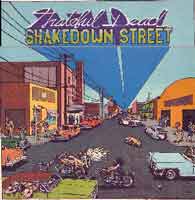 Der zweite Versuch der Dead bei Arista eine Platte zu machen, die auch
Nicht-Dead-Heads gefallen könnte. Dieses mal, man höre und
staune, von Lowell George (Little Feat)
produziert. Zwar kein kommerzieller "Durchbruch", warf die
Platte aber immerhin drei zukünftige Konzertklassiker ab: das Titelstück
von Jerry Garcia, "I Need A Miracle" von Bob Weir
und "Fire On The Mountain" von Schlagzeuger Mickey Hart.
Dazu kamen Neuaufnahmen von 2 Konzertklassikern aus der Frühphase
der Band mit Pig Pen: "New Minglewood Blues" und "Good
Lovin´". Letzteres Stück, soweit ich weiss, ein Hit
von den Rascals aus den 60ern, wurde dann auch ein "Klassiker"
im Live-Repertoire von den Rusty
Nails, inspiriert von der Dead-Version aus der Rockpalast-Nacht.
Der zweite Versuch der Dead bei Arista eine Platte zu machen, die auch
Nicht-Dead-Heads gefallen könnte. Dieses mal, man höre und
staune, von Lowell George (Little Feat)
produziert. Zwar kein kommerzieller "Durchbruch", warf die
Platte aber immerhin drei zukünftige Konzertklassiker ab: das Titelstück
von Jerry Garcia, "I Need A Miracle" von Bob Weir
und "Fire On The Mountain" von Schlagzeuger Mickey Hart.
Dazu kamen Neuaufnahmen von 2 Konzertklassikern aus der Frühphase
der Band mit Pig Pen: "New Minglewood Blues" und "Good
Lovin´". Letzteres Stück, soweit ich weiss, ein Hit
von den Rascals aus den 60ern, wurde dann auch ein "Klassiker"
im Live-Repertoire von den Rusty
Nails, inspiriert von der Dead-Version aus der Rockpalast-Nacht.
Nach den Aufnahmen verließen Keith Godchaux und seine Frau Donna
Godchaux die Band und gründeten die Heart Of Gold Band mit
Steve Kimock (der heute mit Bob Weir, Phil Lesh und Bruce Hornsby
bei den Other Ones Dead-Songs nachspielt). Nach einem einzigen
Konzert mit seiner neuen Heart Of Gold Band verstarb Keith Godchaux
bei einem Autounfall, war somit schon der zweite tote Ex-Dead-Keyboarder
nach Pig Pen. Auch sein Nachfolger Brent Mydland ereilte
später das gleiche Schicksal, aber als "klassischer"
Rock'n'Roll-Drogentod. Nur Kurzzeit-1969-Keyboarder Tom Constanten
und der Orgelmann der letzten Phase, Vince Welnick, sind noch
unter den Lebenden. Wünschen wir ihnen alles Gute.
Nachtrag: auch Vince Welnick weilt inzwischen nicht mehr unter
den Lebenden, aber Tom Constanten geht's immer noch gut. Aber
der hat ja auch nur für eine einzige Saison bei den Dead mitgespielt
...
(2006)

 Mehr ...
Mehr ...
|
"A solid album from the "Keith & Donna" line-up of
the Dead, a few of the tunes went on to become perennial concert staples.
A little funky in places, it seemed that the Dead were absorbing sounds
from the street and mixing them into the broth they stewed in the musical
hills of their minds. The perfect music for a bop on down the block to
the local tavern for a nice chilly beverage and then a trip through the
park to dig nature for a while. The splendid cover art comes to us by
way of the creator of such titles as "Wonder Warthog" and the
"Fabulous, Furry Freak Brothers". College wouldn't have been
the same without those guys. And who could forget "Fat Freddy's Cat"?
" (TralFaz-Archives)
|
|
| The Grateful Dead: "Go
To Heaven" (Arista, 1980) |
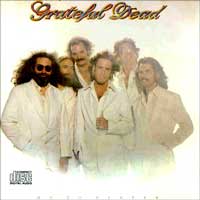 Sicherlich
ist dieses Cover eines der strittigsten auf dieser Themenseite, denn man
kann trefflich darüber debattieren, ob das Cover jetzt wirklich hässlich
oder einfach nur ironisch gemeint ist. Außerdem gibt es viele Deadheads,
die diese Platte musikalisch schlecht finden. Ich dagegen mag sie sehr,
vor allem wegen "Althea", dem schönsten Lied der Essener
Rockpalastnacht mit den Dead. Sicherlich
ist dieses Cover eines der strittigsten auf dieser Themenseite, denn man
kann trefflich darüber debattieren, ob das Cover jetzt wirklich hässlich
oder einfach nur ironisch gemeint ist. Außerdem gibt es viele Deadheads,
die diese Platte musikalisch schlecht finden. Ich dagegen mag sie sehr,
vor allem wegen "Althea", dem schönsten Lied der Essener
Rockpalastnacht mit den Dead.
(20.06.2006) |
| Jerry Garcia: "Run For The
Roses" (Arista, Nov. 1982) |
|
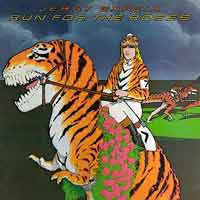 Zum Cover
von Jerrys letztem Studio-Soloalbum fällt mir leider gar nichts
ein. Keine Ahnung, was uns das sagen soll. Die Musik ist leider auch
nur mittelprächtig, u. a. eine Version von Dylans "Knocking
On Heaven's Door", zwar nicht so furchtbar wie die von
Guns'n'Roses, aber eben doch viel zu lang, sowie mit "I
Saw Her Standing There" ein bizarres Beatlescover mit einem mehr
als heftigen Hohner-D6 (Ihr kennt doch sicherlich Stevie Wonders
"Superstition"?), gespielt von Michael Omartian. Zum Cover
von Jerrys letztem Studio-Soloalbum fällt mir leider gar nichts
ein. Keine Ahnung, was uns das sagen soll. Die Musik ist leider auch
nur mittelprächtig, u. a. eine Version von Dylans "Knocking
On Heaven's Door", zwar nicht so furchtbar wie die von
Guns'n'Roses, aber eben doch viel zu lang, sowie mit "I
Saw Her Standing There" ein bizarres Beatlescover mit einem mehr
als heftigen Hohner-D6 (Ihr kennt doch sicherlich Stevie Wonders
"Superstition"?), gespielt von Michael Omartian.
(23.03.2008)
Ich muss mein Urteil etwa revidieren: mit "Midnight Getway"
enthält das Album auch einen der allerbesten Garcia/Hunter-Songs
überhaupt, wie ich jetzt einmal behaupten möchte: über
fast 8 Minuten wird sehr plastisch erzählt und musikalisch untermalt,
wie der Protagonist mitten in der Nacht von seiner Freundin verlassen
wird - von ihrem Rascheln beim Hervorschlüpfen unter der Bettdecke,
über das Klimpern der Schlüssel beim Verlassen des Hauses
und ihrem Zögern auf der Treppe, bis zum immer leiser werdenden
Motorgeräusch ihres Wagens beim Wegfahren - während er wie
gelähmt liegen bleibt, sich zuerst schlafend stellt und sich allmählich
fragt, ober er aufstehen soll, um sie zurückzuhalten - und ob sie
das überhaupt möchte. Großes Ohrenkino! Keine Ahnung,
warum ich dieses Lied bisher immer übersehen bzw. überhört
habe!
(05.02.2010)

 Mehr ...
Mehr ...
Run for the Roses is the last of the studio albums to have come from the Jerry Garcia Band, even though the combo would continue to tour for another 13 years. Sadly, it is also Garcia's most lightweight effort as a bandleader. The disc certainly features a few distinct and redeemable moments; however, taken as whole there are far too many marginal performances for it to be deemed as thoroughly captivating as any of his previous solo work — especially the wholly inspired Cats Under the Stars (1978). Along with John Kahn (bass/fretless bass/synthesizer/piano/clavinet/guitar/slide guitar/electric guitar/co-producer), Garcia chose some interesting cover tunes — such as the impotently executed "I Saw Her Standing There" and the underachieving "Knockin' on Heaven's Door" — the latter of which would become increasingly effective as a live vehicle for the Garcia Band as well as the Grateful Dead during the ensuing years (an ultimate acoustic rendition can be found on the highly recommended and infamous Pizza Tapes from 2000). There are several highlights from the Garcia/Robert Hunter canon, whose brilliance ultimately makes Run for the Roses a justifiable release. Chief among them is the title track, which bops along at an agile pace and formally introduces the effusive organ fills and licks that typify Melvin Seals' style of aggressive interaction with Garcia. Hunter is up to his old lyrical insinuations and poetic ambiguity on "Run for the Roses." Couplets such as "If you got the do-re I got the mi/And I got a notion we're all at sea" are as poignant and poetic as they are Dadaist, reflecting the inherent beauty of Hunter's lyrical prowess. "Valerie" is another standout track; it's a slightly tweaked song dealing with the extremes of an unrequited love. Garcia's vocal is one of his best on this release and perfectly fits the hang-dog mood and persona that Hunter so aptly depicts in the narrative. Both tracks quickly became enthusiasts' favorites and remained in the core rotation of the Garcia Band's performance songbook. On an aesthetic level, Run for the Roses is also notable for the disconcerting artwork by Bay Area visual artist Victor Moscoso. While die-hard enthusiasts may feel as if the disc has more to offer than mentioned above, when contrasted with the material's perpetual on-stage evolution this album falls short of the high standards set by Garcia's earlier studio efforts.
(by Lindsay Planer, All Music Guide)
|
| The Grateful Dead: "In
The Dark" (Arista, Juli 1987) |
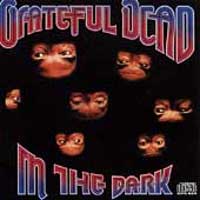 Da
hat mein Herz als alter Deadhead gelacht: nach 7 Jahren Unterbrechung
endlich wieder ein Studioalbum mit neuem Songmaterial - und dann auch
noch wirklich gutes: vor allem "Black
Muddy River", einer meiner absoluter Jerry Garcia/Robert
Hunter-Favouriten, deshalb auch von Waiting For Louise auf "From
6 To 5" gecovert. Dann noch die Hitsingle "Touch Of Grey",
tatsächlich bis auf Platz 9 der US-Singlecharts (das Album kam sogar
bis auf Platz 6!). Zwei gute Bob Weir Songs ("Hell In A Bucket"
und der Livekracher "Throwing Stones"). Nur der Gesangsauftritt
des Keyboarders Brent Mydland ("Tons Of Steel") ist stimmlich
gewöhnungsbedürftig und vom Sound zu sehr Mainstream. Da
hat mein Herz als alter Deadhead gelacht: nach 7 Jahren Unterbrechung
endlich wieder ein Studioalbum mit neuem Songmaterial - und dann auch
noch wirklich gutes: vor allem "Black
Muddy River", einer meiner absoluter Jerry Garcia/Robert
Hunter-Favouriten, deshalb auch von Waiting For Louise auf "From
6 To 5" gecovert. Dann noch die Hitsingle "Touch Of Grey",
tatsächlich bis auf Platz 9 der US-Singlecharts (das Album kam sogar
bis auf Platz 6!). Zwei gute Bob Weir Songs ("Hell In A Bucket"
und der Livekracher "Throwing Stones"). Nur der Gesangsauftritt
des Keyboarders Brent Mydland ("Tons Of Steel") ist stimmlich
gewöhnungsbedürftig und vom Sound zu sehr Mainstream. |
| Robert Hunter: "Liberty"
(Relix, 1987) |
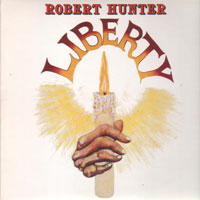

 Mehr ...
Mehr ...
Maybe it was the addition of Jerry Garcia as lead guitarist or just Hunter's growing experience as a singer/ songwriter, but Liberty was a quantum leap from his earlier albums. The backup band was lively and tight (special kudos to drummer David Mann), and Hunter had written a set of playful lyrics, carefully never overwriting and often alluding to earlier folk and rock tunes. (Amazingly, the excellent, album-closing "When A Man Loves A Woman" did not refer to the '60s hit—Hunter claimed never to have heard it when he wrote his song.) He sang with a propulsive energy, such that, on a major label with proper promotion, a song like "Do Deny (Lying Man)" might have had a chance on radio. (If the Grateful Dead had cut it, it would have made a great followup to their 1987 Top Ten hit "Touch Of Grey," co-written by Garcia and Hunter.) Unfortunately, Liberty was the last album of new song material Hunter had produced as of 1996.
(by William Ruhlmann, All Music Guide)
|
| Bob Dylan: "Down In The Groove"
(Columbia, Juni 1988) |
 Sicherlich
nicht eines der besseren Dylan-Alben. Möglicherweise hatte Dylan
zu der Zeit sogar eine Schreibblockade: 5 von 10 Liedern sind Coversongs,
dazu 1 Traditional, nur zwei "reine Dylan Songs" und zwei Kollaborationen
mit Grateful Dead-Texter Robert Hunter. Bemerkenswert sind eigentlich
nur der Dylan-Sing "Death Is Not The End" und die Hunter-Zusammenarbeit
"Sylvio". Sicherlich
nicht eines der besseren Dylan-Alben. Möglicherweise hatte Dylan
zu der Zeit sogar eine Schreibblockade: 5 von 10 Liedern sind Coversongs,
dazu 1 Traditional, nur zwei "reine Dylan Songs" und zwei Kollaborationen
mit Grateful Dead-Texter Robert Hunter. Bemerkenswert sind eigentlich
nur der Dylan-Sing "Death Is Not The End" und die Hunter-Zusammenarbeit
"Sylvio". |
| The Grateful Dead: "Built
To Last" (Arista, Okt. 1989) |
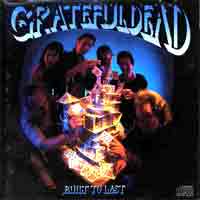 Das
letzte Studioalbum einer meiner allerliebsten Bands, nicht ganz so gelungen
wie "In The Dark", das Comeback von
1987, bzw. eben nicht mehr so überraschend. Das
letzte Studioalbum einer meiner allerliebsten Bands, nicht ganz so gelungen
wie "In The Dark", das Comeback von
1987, bzw. eben nicht mehr so überraschend. |
| Mickey Hart: "Mystery
Box" (Rykodisc, Juni 1996) |
 Für sein zweites, songorientieertes Soloalbum bekam Mickey Hart textliche
Unterstützng seines alten bekannten Robert Hunter und gesangliche
Unterstützung der Ladies von Mint Julip.
Für sein zweites, songorientieertes Soloalbum bekam Mickey Hart textliche
Unterstützng seines alten bekannten Robert Hunter und gesangliche
Unterstützung der Ladies von Mint Julip.
(29.08.2010)

 Mehr ...
Mehr ...
After the passing of Grateful Dead guitarist Jerry Garcia and the venerable band's demise, it was percussionist Mickey Hart who proved to be the most creatively resilient. As Deadheads and appreciators of world music can attest, Hart — who is also an author and learned ethnomusicologist — has been fusing genres ever since his debut release, 1972's Rolling Thunder, which included Native American sounds and motifs along with rock and jazz. Mickey Hart's Mystery Box harks back to that project with his first album of pop-oriented material in nearly a quarter-century. He combines the seemingly disparate world of percussion-based rhythms with traditional "Western-style" structures containing lyrics by Grateful Dead wordsmith Robert Hunter. All the more diverse are the contributions of the Mint Juleps. This female vocal sextet features siblings Debbie Charles, Elizabeth Charles, Marcia Charles, and Sandra Charles as well as Julie Isaac and Debbie Longworth. Collectively, their paradisaical harmonies support Hart's occasional leads, while they're effectively incorporated as primary participants on the infectious groove of the opener, "Where Love Goes (Sito)," and the new wave vibe of "Full Steam Ahead," which is reminiscent of Talking Heads and Tom Tom Club. The Hart-sung "Down the Road" offers a nod to the late Garcia and provides a focal point for Hunter's obviously heartfelt tribute. "Only the Strange Remain" resembles something similar to a latter-era Dead song, bringing to mind "West L.A. Fadeaway" and "Days Between," both in terms of Hunter's piercing insight and a practically tangible noir feeling permeating throughout. The bombastic "John Cage Is Dead" is a masterful amalgam of percussive-heavy world beats in an undulating modern context. "The Last Song" is an apt conclusion as cultures once again collide, yielding a tune that wouldn't have sounded out of place on urban contemporary radio. As the name of this 1996 release suggests, Mickey Hart's Mystery Box has a little something for every taste and reinforces the Grateful Dead adage "Once in a while you get shown the light, in the strangest of places if you look at it right."
(by Lindsay Planer, All Music Guide)
|
| "Zero" (PopMafia, 1997) |
 Eine
der unbekannteren Bands aus San Francisco mit Musikern, die teilweise
aus anderen Bands bekannt sind: Gitarrist Steve Kimock und Trommler
Greg Anton spielten mit Keith & Donna Godchaux zu Beginn
der 80er in der Heart Of Gold Band. Kimock war dann auch später
in mehreren Bands von Ex-Grateful Dead Musikern quasi als Jerry
Garcia-Ersatz zu hören, u.a. den Other Ones (= Grateful Dead
1998 ohne Garcia) und bei Phil Lesh & Friends. Martin Fierro
ließ sein Saxofon und seine Querflöte bei zahlreichen S.F.-Bands
live und im Studio erklingen (u.a. bei den Grateful Dead, Quicksilver
Messenger Service, Merl Saunders und der Jerry Garcia Band). Zu sieben
der zehn Lieder steuerte niemand anders als Robert Hunter die Texte
bei. Eine
der unbekannteren Bands aus San Francisco mit Musikern, die teilweise
aus anderen Bands bekannt sind: Gitarrist Steve Kimock und Trommler
Greg Anton spielten mit Keith & Donna Godchaux zu Beginn
der 80er in der Heart Of Gold Band. Kimock war dann auch später
in mehreren Bands von Ex-Grateful Dead Musikern quasi als Jerry
Garcia-Ersatz zu hören, u.a. den Other Ones (= Grateful Dead
1998 ohne Garcia) und bei Phil Lesh & Friends. Martin Fierro
ließ sein Saxofon und seine Querflöte bei zahlreichen S.F.-Bands
live und im Studio erklingen (u.a. bei den Grateful Dead, Quicksilver
Messenger Service, Merl Saunders und der Jerry Garcia Band). Zu sieben
der zehn Lieder steuerte niemand anders als Robert Hunter die Texte
bei.
(28.08.2010)

 Mehr ...
Mehr ...
Zero's self-titled fifth album is their second collaboration with the Grateful Dead's songwriter Robert Hunter. This phenomenal work showcases the music diversity of the band as well as Hunter's brilliant lyrics. The album's upbeat opening number "Pit o' Thunder" is a hard-driving blues-rock tune about racing. Songs like this are balanced out with the psychedelic ballad "Spoken Four," which ends with a brilliant spiraling guitar solo by Steve Kimock. The album also tackles political issues with the song "Possession." It has more of a grunge rock feel than most of the group's other work. The lyrics take aim at the problems of mandatory sentencing on drug charges: "I never had a nose for crime/But someone passed a joint one day/Now I'm doing federal time." In the years before Zero joined up with Hunter they were mainly an instrumental outfit, but for this album they only included two, the traditional Latin song "Sun, Sun, Sun" and the group's own "Kissing the Boo-boo." Zero contains no weak tracks and is definitely one of the artistic high points of Zero's career.
(by Curtis Zimmermann, All Music Guide)
|
| Phil Lesh & Friends: "There
And Back Again" (Columbia, Juni 2002) |
|
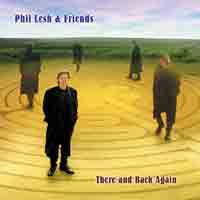 Hier
kommt mein Outing: Natürlich nicht, dass ich ein großer Dead-Fan
bin- warum sollte man das auch verbergen? - sondern dass ich auf die
TV-Serie "Nash Bridges" stehe. Mit den Hauptdarstellern Don
Johnson, den ich wegen Miami Vice früher für einen
totalen Blödmann gehalten habe, und Cheech Marin, dem mexikanischen
Kiffer von Cheech & Chong. Sie spielen dort zwei Cops aus
San Francisco, wobei einer ihrer Kollegen ein totaler Deadhead ist.
Vor einiger Zeit philosophierte erin einer Folge sogar mal über
"Working Man's Dead", während
im Hintergrund die Platte lief. Diese Woche kamen auf VOX die letzten
Folgen der letzten Staffel (schnüff) - mit Phil Lesh in einer Sprechrolle
und einem Konzertausschnitt von Phil Lesh & Friends aus dem Fillmore,
bei dem sie "Bertha" spielen und ihnen von zwei heißen Motorrad-Girls
die Abendkasse geklaut wird. Hach, war das schön. Und vor ein paar
Wochen wurde das bereits im Juni erschienene Album sogar in der Wochenendbeilage
der NRZ besprochen. Weiß der Henker, wie deren Schreiberling da plötzlich
drauf kam - aber egal - ich habe also das Album wieder rausgekramt,
das mir bei der Veröffentlichung vor ein paar Monaten noch viel
zu sehr nach den Allman Brothers geklungen hatte und mir damals
insgesamt zu poppig erschien. Jetzt, mit dem richtigen Schlüsselerlebnis,
muss ich sagen: TOLLE PLATTE. Phil Lesh ist der "wahre Bewahrer"
der Deadkultur (dieser letzte Satz klingt blöde, wird aber nicht
gestrichen). Hier
kommt mein Outing: Natürlich nicht, dass ich ein großer Dead-Fan
bin- warum sollte man das auch verbergen? - sondern dass ich auf die
TV-Serie "Nash Bridges" stehe. Mit den Hauptdarstellern Don
Johnson, den ich wegen Miami Vice früher für einen
totalen Blödmann gehalten habe, und Cheech Marin, dem mexikanischen
Kiffer von Cheech & Chong. Sie spielen dort zwei Cops aus
San Francisco, wobei einer ihrer Kollegen ein totaler Deadhead ist.
Vor einiger Zeit philosophierte erin einer Folge sogar mal über
"Working Man's Dead", während
im Hintergrund die Platte lief. Diese Woche kamen auf VOX die letzten
Folgen der letzten Staffel (schnüff) - mit Phil Lesh in einer Sprechrolle
und einem Konzertausschnitt von Phil Lesh & Friends aus dem Fillmore,
bei dem sie "Bertha" spielen und ihnen von zwei heißen Motorrad-Girls
die Abendkasse geklaut wird. Hach, war das schön. Und vor ein paar
Wochen wurde das bereits im Juni erschienene Album sogar in der Wochenendbeilage
der NRZ besprochen. Weiß der Henker, wie deren Schreiberling da plötzlich
drauf kam - aber egal - ich habe also das Album wieder rausgekramt,
das mir bei der Veröffentlichung vor ein paar Monaten noch viel
zu sehr nach den Allman Brothers geklungen hatte und mir damals
insgesamt zu poppig erschien. Jetzt, mit dem richtigen Schlüsselerlebnis,
muss ich sagen: TOLLE PLATTE. Phil Lesh ist der "wahre Bewahrer"
der Deadkultur (dieser letzte Satz klingt blöde, wird aber nicht
gestrichen).
Kurzer Hinweis zu den "Friends": waren das bisher dauernd
wechselnde Musiker aus Phils Freundeskreis, so hat sich inzwischen eine
feste Truppe herausgebildet. Zwei Hexer an den Gitarren: Warren Haynes
(Allman Brothers, Government Mule) und Jimmy Herring (covert
auch in der Band Jazz Is Dead
zusammen mit Billy Cobham, Alphonso Johnson und anderen Jazzrock-Hochkarätern
die Songs der Dead), dazu Schlagzeuger John Molo (Ex-Bruce Hornsby
& The Range) und der mir unbekannte Keyboarder Rob Barraco.
(30.11.2002)
Das schien mir damals gar nicht besonders erwähnenswert, aber
auch hier stammen 7 von 11 Songtexten von Hunter!
(28.08.2010)
|
| Jim Lauderdale: "Headed
For The Hills" (Dualtone, Mai 2004) |
 Endlich: heute in der Post war nach wochenlangem Warten das neue Werk
meines Lieblinxsongschreibers (zumindest in der Abteilung "Nashville
i.w.S.") mit 13 neuen Liedern - und alle zusammen mit Grateful-Dead-Texter
Robert Hunter geschrieben! Gab's bisher nur einzelne gemeinsame
Lieder, entstand jetzt ein ganzes Album, auf dem Hunter zwar nicht mitspielt
oder mitsingt (hat er bei den Dead ja auch nie gemacht!), aber für
die hohe Qualität des Liedmaterials (irgendwo zwischen Country, Bluesgrass
und Singer/Songwriter) mit zuständig ist. Neben den Liedern selber
ist die Umsetzung auch wunderbar gelungen: fast durchweg bluesgrassig-akustisch
und nur spärlich mit E-Gitarre, Keyboards(!) und Pedalsteel, aber
nur ein einziges mal mit Schlagwerk. Obwohl sich die Grossen der "alternativen"
Nashvilleszene die Klinke in die Hand gaben klingt das ganze Album wie
aus einem Guss. Hier das obligatorische Namedropping: Harmonien von Emmylou
Harris, Allison Moorer, Gillian Welch und Buddy Miller,
Saitenzauberei von Darrell Scott, Tim O'Brien, Bryan
Sutton, David Rawlings, Bucky Baxter u. a...
Endlich: heute in der Post war nach wochenlangem Warten das neue Werk
meines Lieblinxsongschreibers (zumindest in der Abteilung "Nashville
i.w.S.") mit 13 neuen Liedern - und alle zusammen mit Grateful-Dead-Texter
Robert Hunter geschrieben! Gab's bisher nur einzelne gemeinsame
Lieder, entstand jetzt ein ganzes Album, auf dem Hunter zwar nicht mitspielt
oder mitsingt (hat er bei den Dead ja auch nie gemacht!), aber für
die hohe Qualität des Liedmaterials (irgendwo zwischen Country, Bluesgrass
und Singer/Songwriter) mit zuständig ist. Neben den Liedern selber
ist die Umsetzung auch wunderbar gelungen: fast durchweg bluesgrassig-akustisch
und nur spärlich mit E-Gitarre, Keyboards(!) und Pedalsteel, aber
nur ein einziges mal mit Schlagwerk. Obwohl sich die Grossen der "alternativen"
Nashvilleszene die Klinke in die Hand gaben klingt das ganze Album wie
aus einem Guss. Hier das obligatorische Namedropping: Harmonien von Emmylou
Harris, Allison Moorer, Gillian Welch und Buddy Miller,
Saitenzauberei von Darrell Scott, Tim O'Brien, Bryan
Sutton, David Rawlings, Bucky Baxter u. a...
(09.09.2004)

 Mehr ...
Mehr ...
seit etwa 5 Jahren arbeitet Lauderdale phasenweise mit dem ehemaligen Jerry Garcia/Grateful Dead-Obertexter Robert Hunter zusammen, auf allen jüngeren Alben ist mindestens eine derartige Teamarbeit zu hören gewesen. Nun der große Showdown: Alle 13 Tracks sind brandneue Kompositionen der beiden Musiker, die eigentlich aus sehr unterschiedlichen Ecken der Americana-Historie stammen. Nicht nur in den stark umrissenen Charakteren von 'Sandy Ford (Barbara Lee)', 'Trashcan Tomcat', 'Crazy Peg And Darby Doyle' oder 'Joanne' ist Hunter's deutliche Handschrift gut zu hören. Lauderdale singt wie immer göttlich in seinem ganz eigenen Kosmos zwischen Folk, Country und Bluegrass, verbindet Tradition und Moderne wie kein anderer in diesem Bereich! Die Begleitung ist wieder exzeptionell: Darrell Scott, Bryan Sutton, Byron House, Tim O'Brien, David Rawlings & Gillian Welch, Pat McGrath, Bucky Baxter, Emmylou Harris, Buddy Miller, Allison Moorer und auf 'Upside Down', der einzigen elektrischen Roots Rock-Nummer, Donna The Buffalo. Wieder sehr, sehr empfehlenswert!!
(Glitterhouse)
One of the most immediately notable things about the ever-prolific Jim Lauderdale's Headed for the Hills is who's not listed on the cover: lyricist Robert Hunter. Hunter does not perform on the set, but he co-wrote every song. If you are incredulous in wondering why Hunter should receive a billing credit, the answer is simple: there is an elegance and beauty to this album that would never have existed without him. Lauderdale is a fine songwriter, but he does not possess the romantic historical classicism and formalism that Hunter does. In fact, with the possible exception of Bob Dylan, no one in American roots music does. On first listen, what grips the listener is how much of a piece these songs are. They feel like a song cycle of life slices from the rural edges of American life. Rich with guitars, fiddles, harmony vocals, mandolins, and a distinct lack of drums, this is back porch, Saturday night music, played among friends while observing the passing day, the surrounding terrain, legends, and the places in the heart that are not easily given over to conversation. Hunter is a master at communicating the interconnectedness of all three; he has the ability to make the commonplace epic, which he does with Lauderdale's stunning, out-of-antiquity melodies. But this is a stretch for Hunter too; there is no slow California stroll in his approach because Lauderdale's melodies are rooted in the urgency of rural and mountain music from the Civil War as well as modern bluegrass and antiquated American folk songs derived from Anglo-Celtic balladry. Lauderdale understands tradition in a way few modern songwriters do -- he's not interested in taming it for the sake of palatability, or taking away its weird, unsettling alien power. There are a boatload of guests on this set, including instrumentalists Darrell Scott, Tim O'Brien, Donna the Buffalo, and David Rawlings, as well as singers Buddy Miller, Gillian Welch, Emmylou Harris, and Allison Moorer. While there are at least three core bands on these sessions, almost all the songs feel like they were recorded in a single session with the exception of the closer, "Upside Down," with Donna the Buffalo providing their own quirky brand of accompaniment. While there are no thruway tracks, standouts include "Paint and Glass," "Headed for the Hills," "Tales From the Sad Hotel," "High Timberline," and "Joanne."
(by Thom Jurek, All Music Guide)
|
| Bob Dylan: "Together Through
Life" (Columbia, April 2009) |
|
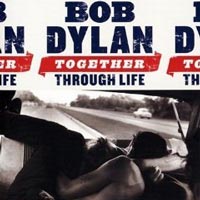 Nach Van Morrison und Neil
Young nun der dritte meiner alten Helden mit einem neuen Album.
Ich will auch jetzt gar nicht viel an dieser Platte herumdeuteln - nur
so viel vom ersten Höreindruck: sie klingt schön, macht Spaß zu hören.
Ein Meisterwerk? Keine Ahnung! Besser oder schlechter als "Modern
Times"? Abermals: keine Ahnung. Vielleicht "zugänglicher"
(nicht zu verwechseln mit "kommerzieller"). Aber auf jeden
Fall deutlich besser als "Fork" von Old
Neil. Mir gefällt es fast so gut wie Van Morrisons Neuinterpretation
von "Astral Weeks", aber da hinkt
der Vergleich, denn das ist ja "nur" ein Livealbum - allerdings
mit seinen besten Songs. Ansonsten: Neugierige lesen meine beigefügten
Rezensionen der Fachleute (keine Angst: Dylanologen kommen nicht zu
Wort!).
Nach Van Morrison und Neil
Young nun der dritte meiner alten Helden mit einem neuen Album.
Ich will auch jetzt gar nicht viel an dieser Platte herumdeuteln - nur
so viel vom ersten Höreindruck: sie klingt schön, macht Spaß zu hören.
Ein Meisterwerk? Keine Ahnung! Besser oder schlechter als "Modern
Times"? Abermals: keine Ahnung. Vielleicht "zugänglicher"
(nicht zu verwechseln mit "kommerzieller"). Aber auf jeden
Fall deutlich besser als "Fork" von Old
Neil. Mir gefällt es fast so gut wie Van Morrisons Neuinterpretation
von "Astral Weeks", aber da hinkt
der Vergleich, denn das ist ja "nur" ein Livealbum - allerdings
mit seinen besten Songs. Ansonsten: Neugierige lesen meine beigefügten
Rezensionen der Fachleute (keine Angst: Dylanologen kommen nicht zu
Wort!).
Einziges, aus meiner Sicht noch erwähnenswertes Detail, ist die erneute
Zusammenarbeit mit Grateful Dead-Lyriker Robert Hunter
(das gab's schon mal in den 80ern bei "Sylvio" und "Ugliest
Girl In The World" vom ansonsten schwachen Album "Down
In The Groove"). Neun von 10 Texten stammen von Dylan und Hunter,
wobei ich nicht beurteilen kann, welche Relevanz das hat und ob man
das irgendwo heraushören oder -lesen kann. Auf jeden Fall gönne ich
Robert Hunter die Tantiemen.
Fast am Ende versteckt sich mit "I Feel a Change Comin' On"
sogar ein kleiner Ohrwurm, wie ihn Dylan schon lange nicht mehr hinbekommen,
bzw. wohl besser gesagt: versucht hat! Das Lied könnte sogar von Van
Morrison sein (ihr wisst schon: diese typischen Harmonien von "Bright
Side Of The Road").
Wenn Hunter dann irgendwann mal die Lieder selber singen sollte, kann
man auch ganz fiese herumnörgeln: Dylansongs von jemandem, der noch
schlechter singt als Dylan selber. Wobei mir gerade auffällt: Dylan
singt eigentlich ganz gut auf "Together Through Live"! OK:
das war jetzt gemein. Hunter ist ein ganz toller Texter, Dylan sowieso.
(18.05.2009)
Nach längerer Zeit hab ich die CD mal wieder eingelegt ("aufgelegt"
könnte man ja nur sagen, wenn es denn eine echte Schallplatte wäre!):
ein "ganz ordentliches" Album, von hoher Qualität für
solch einen "alten Sack" wie Herrn Zimmermanm- aber irgendwie
ist es mir als Höhrer insgesamt doch etwas zu "altbacken":
zu viel Blues und Texmex und zu wenig interessante Produktionsdetails.
Nur "I Feel A Change Coming On" ragt da ein wenig heraus.
Aber trotzdem ist es um Klassen besser als "Fork
On The Road" von Mr. Young.
(28.09.2009)

 Mehr ...
Mehr ...
Eigentlich hatte man erwartet, dass Dylan mit Album Nummer 46 weitermacht in der Richtung die seine letzen beiden Alben Love & Theft und Modern Times vorgaben: Zeitlose, souveräne Blues- und Folk-Songs wie aus der Prä-Rock&Roll-Ära. Ein Bruch ist Together Through Life nun nicht geworden, aber Dylan setzt viele überraschende neue Akzente: Da sind die prägnanten Texmex-Klänge mit dem Akkordeon David Hidalgos von Los Lobos und die ganze Grundstimmung des Albums - man fühlt sich wie auf einer Reise an der mexikanischen Grenze entlang, mit Dylan, Robert Johnson und Tom Waits als Reisepartner. Neu auch, dass die Songs vom Grateful-Dead-Songschreiber Robert Hunter mitverfasst wurden. Und vor allem: Die Songs treffen noch viel stärker ins Herz als auf den letzen beiden Alben - dort wo sich beim Hören auf Modern Times Ehrfurcht und Hochachtung einstellten fließt bei Together Through Life Herzblut.
Ein fantastisches Album - ob Together Through Life nun "das Beste, Schönste und Größte, was der Meister in den letzten dreißig Jahren seinem Publikum ausgeliefert hat" (Süddeutsche Zeitung) ist oder einfach nur ein Werk, das mit Alben wie Oh Mercy und Time Out Of Mind, den großen Dylan-Werken der 80er und 90er, auf einer Stufe steht ist dabei an sich gleichgültig.
(Hanno Güntsch, amazon)
Blues reinsten Quellwassers bestimmte zuletzt das musikalische Oeuvre Bob Dylans. Nach zehn Jahren scheint sich der Anachronist daran abgearbeitet zu haben und vermischt auf seinem neuen Album "Together Through Life" TexMex und Americana. Zeitenwende? Epilog? Oder nur ein cleverer Schachzug?
Zwar schrieb Ex-Beatle Paul McCartney den famosen Song "The Long And Winding Road", einem anderen schien er aber wie auf den Leib geschneidert: Vor knapp zwanzig Jahren versankt Bob Dylan in der Bedeutungslosigkeit und wer ihm die Stange hielt, galt entweder als Ewiggestriger oder taub auf beiden Ohren. Der ehemals begnadete Songwriter verkraftete die Achtziger ebenso wenig wie viele seiner Kollegen und weigerte sich mit Kräften, irgendwelchen Trends zu folgen - egal ob es sich um Aufnahme- oder Gesangstechnik handelte. Stattdessen nahm er zwei dubiose Coveralben auf, die er Anfang der Neunziger unter Ausschluss der Öffentlichkeit herausbrachte.
Doch sowohl "Good As I Been To You" (1992), als auch "World Gone Wrong" (1993) gaben ihm ungeahnte Kreativitätsschübe und selbst heute rätseln eine Reihe Musikwissenschaftler, ob seine Interpretationen uralter amerikanischer Folk-Songs das eigentliche Comeback von His Bobness darstellen. Welches offiziell erst mit "Time Out Of Mind" von 1997 eintrat: Jener düsteren Kontemplation, die in elf erschütternden Tiraden das Gesamtwerk von Kierkegaard und Schopenhauer umfasste. Anschließend widmete sich Dylan dem Blues und wurde zu der Ikone, die selbst Spätgeborene verehren.
Als Anfang des Jahres das Gerücht die Runde machte, "Seine Unantastbarkeit" sei im Studio zu Gange, kursierten in Foren, Blogs und auf diversen Fan-Pages die wildesten Gerüchte: Wird es eine Fortsetzung des 2006 erschienenen "Modern Times"? Präsentiert sich Dylan wieder als Kulturkritiker und prangert die Postmoderne an? Erstaunlicherweise ist "Together Through Life" nichts von alledem, denn schon das Cover - ein Foto von einem über den Highway brausenden Truck mit einem wild knutschenden Pärchen, geschossen vom Magnum-Fotografen Bruce Davidson - verwundert und treibt sämtliche Spekulationen in eine andere Richtung: Glaubt der Schwarzseher wider Willen plötzlich an die Liebe?
Ganz so abwegig ist der Gedanke nicht, denn im Opener heißt es: "I love you pretty baby/ You're the only love I've ever known/ Just as long as you stay with me/ The whole world is my throne". Eine Liebes-Hommage der rohen und desillusionierenden Art, denn kurz vor Schluss revidiert Dylan trocken: "Beyond here lies nothing/ Nothing we can call our own". Und doch bringt dieser Song eine ungewohnte Spielfreude mit sich - Akkordeon, Violinen und gelegentliche Trompeten erschaffen einen ungewohnt ruppigen Sound. Der auch die nachfolgenden Stücke prägt - welche sich allesamt der Liebe, der Verführung und der Erinnerung widmen. Nichts wirklich Neues und trotzdem hätten die wenigsten ein Trinkerlied wie "Shake Shake Mama" vom 67-jährigen Bob Dylan erwartet.
Als wolle er den Fuß nicht vom Gas nehmen, präsentiert sich selbst die herzzerreißende Ballade "I Feel A Change Comin' On" getrieben und rastlos. Völlig überraschend singt Dylan sogar! Zuletzt schien seine Stimme in eine Art Sprechgesang versunken und nun wagt er sich zum ersten Mal seit gefühlten zwei Dekaden zurück zur Melodie. "Some people they tell me/ I've got the blood of the land in my voice", bekräftigt das Stück und lässt den Eindruck entstehen, hier zimmere jemand sein eigenes Denkmal. Eine erneute Fehleinschätzung: "Everybody got all the flowers/ I don't have one single rose".
Ja, es ist Bob Dylan in Reinform, der auf "Together Through Life" zehn Songs entwirft, die genauso aus der Zeit fallen, wie sie großartiger nicht sein könnten. Er muss niemanden mehr etwas beweisen, den Aufrechten Gang haben wir längst verlernt. Ob es jedoch wirklich eine Sommerplatte ist, wie viele Magazine behaupten, wird sich in den kommenden Monaten herausstellen.
Eigentlich egal, denn sein 33tes Studioalbum ist ein philosophisches Meisterwerk: Es katapultiert Dylan - getreu seines antizyklischen Songwritings - in bislang ungeahnte Sphären. Together through life, indeed!
(motor.de)
More so than Modern Times - a good record, but one which lacked a 24-carat humdinger, a Mississippi or a Love Sick - Together Through Life is an album that gets its hooks in early and refuses to let go. It's dark yet comforting, with a big tough sound, booming slightly like a band grooving at a soundcheck in an empty theatre. And at its heart there is a haunting refrain. Because above everything this is a record about love, its absence and its remembrance.
(Mojo. ****)
|
| New Riders Of The Purple Sage: "Where
I Come From" (Woodstock, Juni 2009) |
 Bereits
seit etwa vier oder fünf Jahren gibt es einer der besten Hippie-Countryrockbands
ja nun schon wieder. "Where I Come From" ist ein neues Studiowerk
- das erste seit den 80ern - und es lingt zwar wenig überraschend,
ist aber trotzdem sehr schön geworden! Gründungsmitglied David
Nelson (Gitarre/Gesang) und Buddy Cage, der etwa 1970 Jerry
Garcia als hauptamtlichen Pedal Steeler bei den Riders abgelöst
hat, haben neue Musiker um sich geschart und sogar durch den Grateful
Dead-Texter Robert Hunter Hilfe beim Songwriting bekommen. Bereits
seit etwa vier oder fünf Jahren gibt es einer der besten Hippie-Countryrockbands
ja nun schon wieder. "Where I Come From" ist ein neues Studiowerk
- das erste seit den 80ern - und es lingt zwar wenig überraschend,
ist aber trotzdem sehr schön geworden! Gründungsmitglied David
Nelson (Gitarre/Gesang) und Buddy Cage, der etwa 1970 Jerry
Garcia als hauptamtlichen Pedal Steeler bei den Riders abgelöst
hat, haben neue Musiker um sich geschart und sogar durch den Grateful
Dead-Texter Robert Hunter Hilfe beim Songwriting bekommen.
Seit vielen Jahren ist David Nelson ja bereits in der Jamband-Szene
aktiv und hilft dabei mit seiner eigenen David Nelson Band und
den wiederauferstandenen New Riders eine Lücke zu schließen,
die von den Grateful Dead nach
deren Ende hinterlassen wurde. Und im Gegensaz zu den live ebenfalls aktiven
Phil Lesh, Bob Weir und Mickey Hart gibt es hier
auch mal etwas für solche Deadheads wie mich, die ab und zu gerne
mal neue Songs aus der Feder von Robert Hunter hören wollen
...
(12.09.2009)

 Mehr ...
Mehr ...
For what they describe as their first studio album in 20 years, the New Riders of the Purple Sage, as "revived" in 2005, consist of founding member David Nelson (vocals, guitar); Buddy Cage, who took over from Jerry Garcia on pedal steel guitar after the first album in 1971; and three newbies, guitarist Michael Falzarano, bassist Ronnie Penque, and drummer Johnny Markowski. (Conspicuous by his absence is co-founder John Dawson, who is said to be retired.) Falzarano, who has made a career out of supporting musicians of the '60s San Francisco Sound (he was also a latter day member of Hot Tuna), produced the album. He gets two compositions, both of which he sings, and Penque and Markowski get one each, also displaying their lead vocal abilities. But the heart of the album — seven songs out of 12 — is the work of the new songwriting team of Nelson and Robert Hunter. The teaming itself is not new at all. Nelson and Hunter played together, along with Garcia, in folk and country bands in Palo Alto in the early '60s, prior to the formation of the Grateful Dead, for which Hunter served as primary lyricist. But as songwriters, this is a new association, and a happy one, as Hunter comes up with his typically aphoristic, imagistic, and vernacular words (particularly on the title song) and Nelson matches them with catchy, country-tinged melodies that the band plays in frisky country-rock roadhouse arrangements. This may be San Francisco music, but Bakersfield doesn't seem far away as the guitars go twangy and Cage plays down the weepy side of the pedal steel in favor of something more stinging. These New Riders jam a bit more than the original ensemble, and they also rock a bit more. Put it this way: the final track, "Rockin' with Nona" could segue into "Six Days on the Road" without missing a beat or, nearly, changing the chord pattern. It wouldn't be surprising if, in concert, it does.
(by William Ruhlmann, All Music Guide)
|
| Jim Lauderdale: "Patchwork
River" (Thirty Tigers, Mai 2010) |
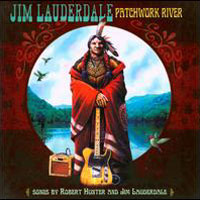 Nach "Headed For The Hills" (2004)
ist dies hier bereits die zweite Kooperation mit Grateful
Dead-Texter Robert Hunter über Albumlänge. Die Kombination
Indianer & Telecaster
auf dem Cover hatten wir ansonsten schon mal bei Eddie
Clearwater.
Nach "Headed For The Hills" (2004)
ist dies hier bereits die zweite Kooperation mit Grateful
Dead-Texter Robert Hunter über Albumlänge. Die Kombination
Indianer & Telecaster
auf dem Cover hatten wir ansonsten schon mal bei Eddie
Clearwater.
Die Musik? Wieder etwas mehr "Rock" und weniger "Honky
Tonk", was mir (momentan) eher entgegenkommt. Die Band ist (wie immer
bei Jim Lauderdale) vom Feinsten: u.a. sind Trommler Chad Cromwell
(Neil Young), Telecastergott James
Burton (Elvis P., Elvis C.,
Gram & Emmylou),
Steelgitarrist Al Perkins (Manassas,
Emmylou), Trommler Ron Tutt
(Elvis P., Elvis C., Jerry
Garcia, Emmylou), Bassist Gary
Tallent (Bruce Springsteen)
und Sängerin/Songschreiberin Patti Griffin dabei.
Gute Zutaten und gute Zubereitung garantieren hie eine äußerst
schmackhafte Mahlzeit!
(31.07.2010)

 Mehr ...
Mehr ...
... nach all den vielen Bluegrass-Projekten der letzten Jahre, all den Country-, Country Pop- und Folk-Alben überrascht der bekannte Nashville-Crooner/Songwriter auf seinem 19. Werk seit 1991 (!!) mit einer ungewohnt satten, kräftigen, rockigen Americana/Country Rock/Roots-Mischung, die einen von der ersten Sekunde an richtig packt. Wie schon auf der 2004er 'Headed For The Hills' (und vereinzelt auf so manchen anderen CDs) wurden alle 13 neuen Tracks in fester und deutlich herausgestellter Zusammenarbeit mit dem ehemaligen Grateful Dead-Lyriker Robert Hunter geschrieben. 13 absolute Klasse-Songs, die neben Country in vielen Schattierungen jede Menge Southern Soul (Muscle Shoals bis Memphis) in sich tragen und etwa 50/50 aus Balladen und rock'n'rolligen schnelleren Stücken bestehen. Lauderdale und Hunter sind ein wahres Traumpaar, wenn es darum geht, bildstarke, wortreiche Geschichten in 4 Minuten zu verpacken - das ist dann schlicht allerallerhöchste Erzählkunst! Habe ich sicher schon oft getan, aber ich muss hier wieder mal Lauderdale's unglaubliche gesangliche Vielseitigkeit betonen. Wie kaum ein anderer ist er in der Lage, sich auf das jeweilige Songfeeling einzustellen, seiner Stimme verschiedenste Klangfarben zu entlocken. Keine Frage natürlich, dass er wieder nur die besten Musiker zur Verfügung hat: Kenny Vaughan, James Burton und Doug Lancio an den elektrischen Gitarren, Al Perkins oder Robby Turner an der Pedal Steel, dazu John Jarvis, John Deaderick, Garry Tallent, Byron House, Chad Cromwell, Bryan Owings, Ron Tutt, Stuart Duncan, Jim Hoke, als Harmony Singers Ann & Regina McCrary sowie Patty Griffin. Hochgradig überzeugend, ja, ich habe den Eindruck, dieser Typ wird immer noch ein bisschen besser!!
(Glitterhouse)
Jim Lauderdale has never been known to shy away from a worthwhile collaboration, having cut some outstanding sessions with bluegrass icon Ralph Stanley and sat in with a broad range of artists from Lucinda Williams and Dwight Yoakam to Solomon Burke and Elvis Costello. And Patchwork River finds Lauderdale teaming up once again with Robert Hunter, with whom he previously collaborated on 2004's Headed for the Hills. Patchwork River features 13 new songs Lauderdale wrote in tandem with Hunter, best known for his work as a lyricist with the Grateful Dead. As one of the few men in Nashville with the courage of his country music convictions these days, Lauderdale moves significantly closer to rock & roll than usual on this album, though this music is still strong, rootsy stuff, with a potent, bluesy undercurrent audible on "Louisville Roll," "Jawbone," and the title tune, and plenty of full-on guitar howling on "Winonna." (Don't fret, "Between Your Heart and Mine" and "Far in the Far Away" demonstrate Lauderdale still writes a great country tune.) These songs are clearly collaborations between two writers, but Lauderdale's melodies bend themselves to the armature of Hunter's elliptical wordplay on Patchwork River, and the rhythms of the tunes sometimes recall Hunter's work with Jerry Garcia, even though Lauderdale's vocals are as distinctive as ever and his own melodic sense is clearly felt. Given the lyrics Hunter has written for this project, it wouldn't have been at all difficult to turn Patchwork River into a pseudo-Dead album in the manner of Workingman's Dead or American Beauty, and to his credit that's not what Jim Lauderdale has done, any more than he did on the previous Headed for the Hills. While it sounds and feels like a different sort of Lauderdale album, Patchwork River is still his own work, and on this second outing with Hunter he's allowed the partnership to inform his music without robbing it of his individual spirit, and similarly he hasn't diluted Hunter's poetic sensibility in the process.
(by Mark Deming, All Music Guide)
|

 Der
dritte Streich meiner Helden, noch etwas unausgegoren, aber schon mit
einigen Klassesongs (z.B. "Saint Stephen" und "China Cat
Sunflower", fast alle Texte inzwischen von bandeigenen Lyriker Robert
Hunter und die Musik von Leadgitarrist Jerry Garcia mit gelegentlicher
Unterstützung von Bassist Phil Lesh), denn ihre psychedelischen
Exkursionen kamen erst live voll zur Geltung, weshalb wenige Monate später
auch das Live-Doppelalbum "Live/Dead"
erst den Durchbruch brachte. Im Studio gelangen die Bigpoints erst später
mit den Countryrockalben "Workingman's Dead"
und "American Beauty" von 1970.
Der
dritte Streich meiner Helden, noch etwas unausgegoren, aber schon mit
einigen Klassesongs (z.B. "Saint Stephen" und "China Cat
Sunflower", fast alle Texte inzwischen von bandeigenen Lyriker Robert
Hunter und die Musik von Leadgitarrist Jerry Garcia mit gelegentlicher
Unterstützung von Bassist Phil Lesh), denn ihre psychedelischen
Exkursionen kamen erst live voll zur Geltung, weshalb wenige Monate später
auch das Live-Doppelalbum "Live/Dead"
erst den Durchbruch brachte. Im Studio gelangen die Bigpoints erst später
mit den Countryrockalben "Workingman's Dead"
und "American Beauty" von 1970. Sorgten sie noch im Jahr zuvor mit ihren Endlosjams (verdientermassen)
für Aufmerksamkeit ("Live/Dead"
von 1969), so glänzten sie im Jahr 1970 durch zwei wunderbare, songorientierte
Alben, die ihre Countrywurzeln deutlich werden liessen. Jerry Garcia
entdeckte die Pedalsteel und es erklingt mehrstimmiger Gesang á
la CSN&Y. Zahlreiche Dead-Klassiker finden sich auf diesem Album:
"Uncle John's Band", "Dire Wolf", "Cumberland
Blues", "Black Peter" und "Casey Jones".
Sorgten sie noch im Jahr zuvor mit ihren Endlosjams (verdientermassen)
für Aufmerksamkeit ("Live/Dead"
von 1969), so glänzten sie im Jahr 1970 durch zwei wunderbare, songorientierte
Alben, die ihre Countrywurzeln deutlich werden liessen. Jerry Garcia
entdeckte die Pedalsteel und es erklingt mehrstimmiger Gesang á
la CSN&Y. Zahlreiche Dead-Klassiker finden sich auf diesem Album:
"Uncle John's Band", "Dire Wolf", "Cumberland
Blues", "Black Peter" und "Casey Jones".
 Mehr ...
Mehr ...
 Kurz nach "Working Man's Dead" der
zweite Geniestreich der Dead, diesmal mit "Friend Of The Devil",
"Box Of Rain" (Phil Lesh singt!), "Sugar Magnolia",
"Candyman", "Ripple" und "Truckin'". Letzter
Titel kam dem am nächsten, was man bei den Dead einen Singlehit nennen
könnte.
Kurz nach "Working Man's Dead" der
zweite Geniestreich der Dead, diesmal mit "Friend Of The Devil",
"Box Of Rain" (Phil Lesh singt!), "Sugar Magnolia",
"Candyman", "Ripple" und "Truckin'". Letzter
Titel kam dem am nächsten, was man bei den Dead einen Singlehit nennen
könnte.
 Mehr ...
Mehr ...
 Diese
Platte hat Jerry (fast) alleine aufgenommen, er wurde nur vom Dead-Trommler
Bill Kreutzmann unterstützt. Enthält neben einigen Soundexperimenten
ein paar tolle Songs, die schnell den Weg in das Bühnenrepertoire
der Dead fanden: "Deal", "Birdsong", "Sugaree",
"Loser", "To Lay Me Down" und "The Wheel".
Diese
Platte hat Jerry (fast) alleine aufgenommen, er wurde nur vom Dead-Trommler
Bill Kreutzmann unterstützt. Enthält neben einigen Soundexperimenten
ein paar tolle Songs, die schnell den Weg in das Bühnenrepertoire
der Dead fanden: "Deal", "Birdsong", "Sugaree",
"Loser", "To Lay Me Down" und "The Wheel". Die
erste Veröffentlichung auf dem bandeigenen Plattenlabel - eine wunderbare
Platte (ich bin als verkappter "Deadhead" da aber wohl nicht
besonders objektiv). Deshalb hier nur ein paar Fakten: die erste Platte
nach dem Tod von Pigpen und auch die erste Studioproduktion mit
dem neuen Keyboarder Keith Godchaux, der hier auch zum ersten und
einzigen mal in seiner Deadzeit singt ("Let Me Sing Your Blues Away").
Ebenfalls neu dabei seine Frau Donna Jean Godchaux als Chorsängerin
(sie tritt aber kaum in Erscheinung und war wegen ihrer Rolle in der Band
auch immer ein Diskussionspunkt für Fans). Von Jerry Garcia
gibt es mehrere gute Songs ("Half-Step Missisppi...", "Stella
Blue" und "Row Jimmy"), nur die Single "Eyes Of The
World" ist nach meiner Geschmack etwas schwächer. Von Bob
Weir hören wir eine mehrteilige "Weather Report Suite",
Bill Kreutzmann muss z. Z. ohne seinen Trommelpartner Mickey
Hart auskommen, Phil Lesh ist am Bass wie immer genial, aber
mal wieder ohne eigene Songs und Gesangsversuche. Ungewöhnlich ist
die große Anzahl von Gastmusikern (Doug Sahm, Matt Kelly,
Vassar Clements, Martin Fierro u.a.). Das Album wurde übrigens
von der Band Jazz Is Dead komplett gecovert ("Laughing
Water", Zebra 1999)!
Die
erste Veröffentlichung auf dem bandeigenen Plattenlabel - eine wunderbare
Platte (ich bin als verkappter "Deadhead" da aber wohl nicht
besonders objektiv). Deshalb hier nur ein paar Fakten: die erste Platte
nach dem Tod von Pigpen und auch die erste Studioproduktion mit
dem neuen Keyboarder Keith Godchaux, der hier auch zum ersten und
einzigen mal in seiner Deadzeit singt ("Let Me Sing Your Blues Away").
Ebenfalls neu dabei seine Frau Donna Jean Godchaux als Chorsängerin
(sie tritt aber kaum in Erscheinung und war wegen ihrer Rolle in der Band
auch immer ein Diskussionspunkt für Fans). Von Jerry Garcia
gibt es mehrere gute Songs ("Half-Step Missisppi...", "Stella
Blue" und "Row Jimmy"), nur die Single "Eyes Of The
World" ist nach meiner Geschmack etwas schwächer. Von Bob
Weir hören wir eine mehrteilige "Weather Report Suite",
Bill Kreutzmann muss z. Z. ohne seinen Trommelpartner Mickey
Hart auskommen, Phil Lesh ist am Bass wie immer genial, aber
mal wieder ohne eigene Songs und Gesangsversuche. Ungewöhnlich ist
die große Anzahl von Gastmusikern (Doug Sahm, Matt Kelly,
Vassar Clements, Martin Fierro u.a.). Das Album wurde übrigens
von der Band Jazz Is Dead komplett gecovert ("Laughing
Water", Zebra 1999)! Nicht
mein Lieblinxalbum der Band, aber eigentlich doch ganz schön! Kleine
Besonderheit: es gibt gleich zwei vom Bassisten Phil Lesh komponierte
und gesungene Lieder ("Unbroken Chain" mit Synthesizereinlagen
von Lesh-Spezie Ned Lagin und der bizarre Countrysong "Pride
Of Cucamonga" mit der Pedalsteel des Doobie Brothers John McFee).
Nicht
mein Lieblinxalbum der Band, aber eigentlich doch ganz schön! Kleine
Besonderheit: es gibt gleich zwei vom Bassisten Phil Lesh komponierte
und gesungene Lieder ("Unbroken Chain" mit Synthesizereinlagen
von Lesh-Spezie Ned Lagin und der bizarre Countrysong "Pride
Of Cucamonga" mit der Pedalsteel des Doobie Brothers John McFee).
 Mehr ...
Mehr ...
 Für
manche ist das die beste Dead-Platte. Zumindest die beste von den Studioplatten.
Nach dem finanziellen Fiasko mit ihrem P.A.-System, dem mittelmäßigen
Album "From The Mars Hotel" und dem
schwachen Filmsoundtrack "Steal Your Face" schafften sie es
zum ersten Mal, ihre jazzige/improvisierende Seite im Studio angemessen
zu präsentieren. Außerdem war der verlorene Sohn Mickey Hart
endlich zurückgekehrt.
Für
manche ist das die beste Dead-Platte. Zumindest die beste von den Studioplatten.
Nach dem finanziellen Fiasko mit ihrem P.A.-System, dem mittelmäßigen
Album "From The Mars Hotel" und dem
schwachen Filmsoundtrack "Steal Your Face" schafften sie es
zum ersten Mal, ihre jazzige/improvisierende Seite im Studio angemessen
zu präsentieren. Außerdem war der verlorene Sohn Mickey Hart
endlich zurückgekehrt. Jerrys drittes Soloalbum, zur Hälfte mit Grateful
Dead, zur hälfte mit seiner eigenen Band (John Kahn, Nicky
Hopkins und Ron Tutt) eingespielt. Ein paar schöne eigene Songs
(ich mag besonders "Comes A Time"), aber auch ein paar sehr
schöne Coversongs (z.B. das entschleunigte und zum Reggae umgebaute Bluegrassstück
"Catfish John" und das wunderbare "On Your Way Down"
von Allen Toussaint). Das Album ist um Klassen besser als sein
Ruf in der Deadhead-Gemeinde.
Jerrys drittes Soloalbum, zur Hälfte mit Grateful
Dead, zur hälfte mit seiner eigenen Band (John Kahn, Nicky
Hopkins und Ron Tutt) eingespielt. Ein paar schöne eigene Songs
(ich mag besonders "Comes A Time"), aber auch ein paar sehr
schöne Coversongs (z.B. das entschleunigte und zum Reggae umgebaute Bluegrassstück
"Catfish John" und das wunderbare "On Your Way Down"
von Allen Toussaint). Das Album ist um Klassen besser als sein
Ruf in der Deadhead-Gemeinde.
 Mehr ...
Mehr ...
 Nachdem ihr eigenes Label finanzielle Probleme bekam, unterschrieben die
Dead zum zweiten Mal bei einer Major-Company. Clive Davis, der
in den 60ern die Band gerne für seinen damaligen Arbeitgeber CBS
verpflichtet hätte, war inzwischen Chef im eigenen Laden Arista.
Erstmals seit "Anthem Of The Sun" (1968) gab es mit Keith
Olsen, der gerade mit Fleetwood Mac's "Rumours"
einen gigantischen Erfolg feierte, auch einen externen Produzenten. Der
Aufschrei war dann groß: MAINSTREAM! SCHRECKLICH! Kurioserweise wurde
"Terrapin Station" dann aber eher das "Progrock-Album"
der Band, was vielleicht am Titelsong liegt, der die ganze B-Seite einnimmt
und mit Orchester- und Choreinsätzen daherkommt. Dabei übersieht
man die guten Songs der A-Seite: Bob Weir's "Estimated Prophet"
ist ein genialer Reggae im 7/4-Takt, "Passenger" der erste Phil
Lesh-Song seit Mars-Hotel-Zeiten, "Sunrise"
das einzige Dead-Stück, das von Donna Godchaux gesungen und
komponiert wurde: hat natürlich nix mit echtem "Dead-Sound"
zu tun, ist aber eine schöne, vielleicht einen "Tacken"
zu kitschig-bombastische, Ballade.
Nachdem ihr eigenes Label finanzielle Probleme bekam, unterschrieben die
Dead zum zweiten Mal bei einer Major-Company. Clive Davis, der
in den 60ern die Band gerne für seinen damaligen Arbeitgeber CBS
verpflichtet hätte, war inzwischen Chef im eigenen Laden Arista.
Erstmals seit "Anthem Of The Sun" (1968) gab es mit Keith
Olsen, der gerade mit Fleetwood Mac's "Rumours"
einen gigantischen Erfolg feierte, auch einen externen Produzenten. Der
Aufschrei war dann groß: MAINSTREAM! SCHRECKLICH! Kurioserweise wurde
"Terrapin Station" dann aber eher das "Progrock-Album"
der Band, was vielleicht am Titelsong liegt, der die ganze B-Seite einnimmt
und mit Orchester- und Choreinsätzen daherkommt. Dabei übersieht
man die guten Songs der A-Seite: Bob Weir's "Estimated Prophet"
ist ein genialer Reggae im 7/4-Takt, "Passenger" der erste Phil
Lesh-Song seit Mars-Hotel-Zeiten, "Sunrise"
das einzige Dead-Stück, das von Donna Godchaux gesungen und
komponiert wurde: hat natürlich nix mit echtem "Dead-Sound"
zu tun, ist aber eine schöne, vielleicht einen "Tacken"
zu kitschig-bombastische, Ballade. Ich habe vor kurzem den teuersten CD-Kauf meines Lebens gemacht, nämlich
die 6-CD-Box "All Good Things - Jerry Garcia Studio Session"
mit allen 5 Solowerken (ohne die zahlreichen Livealben), alle mit zahlreichen
Bonustracks und sogar einer 6. CD mit noch viel mehr. "Cats Under
The Stars" war die Nummer 4 und stand (natürlich) als Vinyl
schon lange im Plattenschrank, wenn auch ewig nicht mehr gehört.
Während die ersten drei Alben ("Garcia"
von 1972, "Garcia" von 1974
- Ihr merkt: Jerry kümmerte sich wenig um Marketing und Plattentitel
-, sowie "Reflections" von 1976)
bereits 1989 von Line-Records auf CD wiederveröffentlicht wurden
und auch viel von mir gehört wurden blieben die beiden Arista-Alben
(1982 kam noch das schwächere "Run For The Roses" raus)
aber irgendwie aus meinem Gedächtnis verschwunden. Jetzt läuft also
seit langer Zeit mal wieder "Cats Under The Stars", während
ich im Begleitbuch schmökere, und muss feststellen: es ist tatsächlich
das beste JGB-Album: alles klasse neue eigene Lieder (von Garcia, Bassist
John Kahn und Sängerin Donna Godchaux), die Band spielt
ausgezeichnet (Donna hat wirklich schöne Gesangsauftritte, Ex-Elvis-Drummer
Ron Tutt ist in Höchstform). Das Ganze hat eine eigentümlich
mystische Stimmung (kann ich nicht besser beschreiben), ganz anders als
bei den Dead, mit denen er fast Zeitgleich das Album "Shakedown Street"
herausbrachte.
Ich habe vor kurzem den teuersten CD-Kauf meines Lebens gemacht, nämlich
die 6-CD-Box "All Good Things - Jerry Garcia Studio Session"
mit allen 5 Solowerken (ohne die zahlreichen Livealben), alle mit zahlreichen
Bonustracks und sogar einer 6. CD mit noch viel mehr. "Cats Under
The Stars" war die Nummer 4 und stand (natürlich) als Vinyl
schon lange im Plattenschrank, wenn auch ewig nicht mehr gehört.
Während die ersten drei Alben ("Garcia"
von 1972, "Garcia" von 1974
- Ihr merkt: Jerry kümmerte sich wenig um Marketing und Plattentitel
-, sowie "Reflections" von 1976)
bereits 1989 von Line-Records auf CD wiederveröffentlicht wurden
und auch viel von mir gehört wurden blieben die beiden Arista-Alben
(1982 kam noch das schwächere "Run For The Roses" raus)
aber irgendwie aus meinem Gedächtnis verschwunden. Jetzt läuft also
seit langer Zeit mal wieder "Cats Under The Stars", während
ich im Begleitbuch schmökere, und muss feststellen: es ist tatsächlich
das beste JGB-Album: alles klasse neue eigene Lieder (von Garcia, Bassist
John Kahn und Sängerin Donna Godchaux), die Band spielt
ausgezeichnet (Donna hat wirklich schöne Gesangsauftritte, Ex-Elvis-Drummer
Ron Tutt ist in Höchstform). Das Ganze hat eine eigentümlich
mystische Stimmung (kann ich nicht besser beschreiben), ganz anders als
bei den Dead, mit denen er fast Zeitgleich das Album "Shakedown Street"
herausbrachte. Mehr ...
Mehr ...
 Mehr ...
Mehr ...
 Sicherlich
ist dieses Cover eines der strittigsten auf dieser Themenseite, denn man
kann trefflich darüber debattieren, ob das Cover jetzt wirklich hässlich
oder einfach nur ironisch gemeint ist. Außerdem gibt es viele Deadheads,
die diese Platte musikalisch schlecht finden. Ich dagegen mag sie sehr,
vor allem wegen "Althea", dem schönsten Lied der Essener
Rockpalastnacht mit den Dead.
Sicherlich
ist dieses Cover eines der strittigsten auf dieser Themenseite, denn man
kann trefflich darüber debattieren, ob das Cover jetzt wirklich hässlich
oder einfach nur ironisch gemeint ist. Außerdem gibt es viele Deadheads,
die diese Platte musikalisch schlecht finden. Ich dagegen mag sie sehr,
vor allem wegen "Althea", dem schönsten Lied der Essener
Rockpalastnacht mit den Dead. Mehr ...
Mehr ...
 Da
hat mein Herz als alter Deadhead gelacht: nach 7 Jahren Unterbrechung
endlich wieder ein Studioalbum mit neuem Songmaterial - und dann auch
noch wirklich gutes: vor allem "Black
Muddy River", einer meiner absoluter Jerry Garcia/Robert
Hunter-Favouriten, deshalb auch von Waiting For Louise auf "From
6 To 5" gecovert. Dann noch die Hitsingle "Touch Of Grey",
tatsächlich bis auf Platz 9 der US-Singlecharts (das Album kam sogar
bis auf Platz 6!). Zwei gute Bob Weir Songs ("Hell In A Bucket"
und der Livekracher "Throwing Stones"). Nur der Gesangsauftritt
des Keyboarders Brent Mydland ("Tons Of Steel") ist stimmlich
gewöhnungsbedürftig und vom Sound zu sehr Mainstream.
Da
hat mein Herz als alter Deadhead gelacht: nach 7 Jahren Unterbrechung
endlich wieder ein Studioalbum mit neuem Songmaterial - und dann auch
noch wirklich gutes: vor allem "Black
Muddy River", einer meiner absoluter Jerry Garcia/Robert
Hunter-Favouriten, deshalb auch von Waiting For Louise auf "From
6 To 5" gecovert. Dann noch die Hitsingle "Touch Of Grey",
tatsächlich bis auf Platz 9 der US-Singlecharts (das Album kam sogar
bis auf Platz 6!). Zwei gute Bob Weir Songs ("Hell In A Bucket"
und der Livekracher "Throwing Stones"). Nur der Gesangsauftritt
des Keyboarders Brent Mydland ("Tons Of Steel") ist stimmlich
gewöhnungsbedürftig und vom Sound zu sehr Mainstream.
 Mehr ...
Mehr ...
 Sicherlich
nicht eines der besseren Dylan-Alben. Möglicherweise hatte Dylan
zu der Zeit sogar eine Schreibblockade: 5 von 10 Liedern sind Coversongs,
dazu 1 Traditional, nur zwei "reine Dylan Songs" und zwei Kollaborationen
mit Grateful Dead-Texter Robert Hunter. Bemerkenswert sind eigentlich
nur der Dylan-Sing "Death Is Not The End" und die Hunter-Zusammenarbeit
"Sylvio".
Sicherlich
nicht eines der besseren Dylan-Alben. Möglicherweise hatte Dylan
zu der Zeit sogar eine Schreibblockade: 5 von 10 Liedern sind Coversongs,
dazu 1 Traditional, nur zwei "reine Dylan Songs" und zwei Kollaborationen
mit Grateful Dead-Texter Robert Hunter. Bemerkenswert sind eigentlich
nur der Dylan-Sing "Death Is Not The End" und die Hunter-Zusammenarbeit
"Sylvio".  Das
letzte Studioalbum einer meiner allerliebsten Bands, nicht ganz so gelungen
wie "In The Dark", das Comeback von
1987, bzw. eben nicht mehr so überraschend.
Das
letzte Studioalbum einer meiner allerliebsten Bands, nicht ganz so gelungen
wie "In The Dark", das Comeback von
1987, bzw. eben nicht mehr so überraschend. Für sein zweites, songorientieertes Soloalbum bekam Mickey Hart textliche
Unterstützng seines alten bekannten Robert Hunter und gesangliche
Unterstützung der Ladies von Mint Julip.
Für sein zweites, songorientieertes Soloalbum bekam Mickey Hart textliche
Unterstützng seines alten bekannten Robert Hunter und gesangliche
Unterstützung der Ladies von Mint Julip. Mehr ...
Mehr ...
 Eine
der unbekannteren Bands aus San Francisco mit Musikern, die teilweise
aus anderen Bands bekannt sind: Gitarrist Steve Kimock und Trommler
Greg Anton spielten mit Keith & Donna Godchaux zu Beginn
der 80er in der Heart Of Gold Band. Kimock war dann auch später
in mehreren Bands von Ex-Grateful Dead Musikern quasi als Jerry
Garcia-Ersatz zu hören, u.a. den Other Ones (= Grateful Dead
1998 ohne Garcia) und bei Phil Lesh & Friends. Martin Fierro
ließ sein Saxofon und seine Querflöte bei zahlreichen S.F.-Bands
live und im Studio erklingen (u.a. bei den Grateful Dead, Quicksilver
Messenger Service, Merl Saunders und der Jerry Garcia Band). Zu sieben
der zehn Lieder steuerte niemand anders als Robert Hunter die Texte
bei.
Eine
der unbekannteren Bands aus San Francisco mit Musikern, die teilweise
aus anderen Bands bekannt sind: Gitarrist Steve Kimock und Trommler
Greg Anton spielten mit Keith & Donna Godchaux zu Beginn
der 80er in der Heart Of Gold Band. Kimock war dann auch später
in mehreren Bands von Ex-Grateful Dead Musikern quasi als Jerry
Garcia-Ersatz zu hören, u.a. den Other Ones (= Grateful Dead
1998 ohne Garcia) und bei Phil Lesh & Friends. Martin Fierro
ließ sein Saxofon und seine Querflöte bei zahlreichen S.F.-Bands
live und im Studio erklingen (u.a. bei den Grateful Dead, Quicksilver
Messenger Service, Merl Saunders und der Jerry Garcia Band). Zu sieben
der zehn Lieder steuerte niemand anders als Robert Hunter die Texte
bei. Mehr ...
Mehr ...
 Endlich: heute in der Post war nach wochenlangem Warten das neue Werk
meines Lieblinxsongschreibers (zumindest in der Abteilung "Nashville
i.w.S.") mit 13 neuen Liedern - und alle zusammen mit Grateful-Dead-Texter
Robert Hunter geschrieben! Gab's bisher nur einzelne gemeinsame
Lieder, entstand jetzt ein ganzes Album, auf dem Hunter zwar nicht mitspielt
oder mitsingt (hat er bei den Dead ja auch nie gemacht!), aber für
die hohe Qualität des Liedmaterials (irgendwo zwischen Country, Bluesgrass
und Singer/Songwriter) mit zuständig ist. Neben den Liedern selber
ist die Umsetzung auch wunderbar gelungen: fast durchweg bluesgrassig-akustisch
und nur spärlich mit E-Gitarre, Keyboards(!) und Pedalsteel, aber
nur ein einziges mal mit Schlagwerk. Obwohl sich die Grossen der "alternativen"
Nashvilleszene die Klinke in die Hand gaben klingt das ganze Album wie
aus einem Guss. Hier das obligatorische Namedropping: Harmonien von Emmylou
Harris, Allison Moorer, Gillian Welch und Buddy Miller,
Saitenzauberei von Darrell Scott, Tim O'Brien, Bryan
Sutton, David Rawlings, Bucky Baxter u. a...
Endlich: heute in der Post war nach wochenlangem Warten das neue Werk
meines Lieblinxsongschreibers (zumindest in der Abteilung "Nashville
i.w.S.") mit 13 neuen Liedern - und alle zusammen mit Grateful-Dead-Texter
Robert Hunter geschrieben! Gab's bisher nur einzelne gemeinsame
Lieder, entstand jetzt ein ganzes Album, auf dem Hunter zwar nicht mitspielt
oder mitsingt (hat er bei den Dead ja auch nie gemacht!), aber für
die hohe Qualität des Liedmaterials (irgendwo zwischen Country, Bluesgrass
und Singer/Songwriter) mit zuständig ist. Neben den Liedern selber
ist die Umsetzung auch wunderbar gelungen: fast durchweg bluesgrassig-akustisch
und nur spärlich mit E-Gitarre, Keyboards(!) und Pedalsteel, aber
nur ein einziges mal mit Schlagwerk. Obwohl sich die Grossen der "alternativen"
Nashvilleszene die Klinke in die Hand gaben klingt das ganze Album wie
aus einem Guss. Hier das obligatorische Namedropping: Harmonien von Emmylou
Harris, Allison Moorer, Gillian Welch und Buddy Miller,
Saitenzauberei von Darrell Scott, Tim O'Brien, Bryan
Sutton, David Rawlings, Bucky Baxter u. a...  Mehr ...
Mehr ...
 Mehr ...
Mehr ...
 Bereits
seit etwa vier oder fünf Jahren gibt es einer der besten Hippie-Countryrockbands
ja nun schon wieder. "Where I Come From" ist ein neues Studiowerk
- das erste seit den 80ern - und es lingt zwar wenig überraschend,
ist aber trotzdem sehr schön geworden! Gründungsmitglied David
Nelson (Gitarre/Gesang) und Buddy Cage, der etwa 1970 Jerry
Garcia als hauptamtlichen Pedal Steeler bei den Riders abgelöst
hat, haben neue Musiker um sich geschart und sogar durch den Grateful
Dead-Texter Robert Hunter Hilfe beim Songwriting bekommen.
Bereits
seit etwa vier oder fünf Jahren gibt es einer der besten Hippie-Countryrockbands
ja nun schon wieder. "Where I Come From" ist ein neues Studiowerk
- das erste seit den 80ern - und es lingt zwar wenig überraschend,
ist aber trotzdem sehr schön geworden! Gründungsmitglied David
Nelson (Gitarre/Gesang) und Buddy Cage, der etwa 1970 Jerry
Garcia als hauptamtlichen Pedal Steeler bei den Riders abgelöst
hat, haben neue Musiker um sich geschart und sogar durch den Grateful
Dead-Texter Robert Hunter Hilfe beim Songwriting bekommen.  Mehr ...
Mehr ...
 Nach "Headed For The Hills" (2004)
ist dies hier bereits die zweite Kooperation mit Grateful
Dead-Texter Robert Hunter über Albumlänge. Die Kombination
Indianer & Telecaster
auf dem Cover hatten wir ansonsten schon mal bei Eddie
Clearwater.
Nach "Headed For The Hills" (2004)
ist dies hier bereits die zweite Kooperation mit Grateful
Dead-Texter Robert Hunter über Albumlänge. Die Kombination
Indianer & Telecaster
auf dem Cover hatten wir ansonsten schon mal bei Eddie
Clearwater. Mehr ...
Mehr ...

 Bob
Weirs Solodebut ist ein verkapptes Grateful Dead - Album, denn er wird
hier durchgängig von seiner Stammband begleitet (Jerry Garcia,
Phil Lesh, Bill Kreutzmann und der Neuzugang Keith
Godchaux). Zum ersten Mal tritt auch Donna Godchaux in Erscheinung,
die danach ebenfalls festes Bandmitglied wurde. Die meisten der Songs
fanden danach auch den Weg in das Dead-Repertoire: "Greatest Story
Ever Told", "Playing In The Band", "Looks Like Rain",
"Cassidy" und "One More Saturday Night". Eines der
besten Dead-Alben, nur eben ohne Garcia-Songs und Garcia-Gesang.
Bob
Weirs Solodebut ist ein verkapptes Grateful Dead - Album, denn er wird
hier durchgängig von seiner Stammband begleitet (Jerry Garcia,
Phil Lesh, Bill Kreutzmann und der Neuzugang Keith
Godchaux). Zum ersten Mal tritt auch Donna Godchaux in Erscheinung,
die danach ebenfalls festes Bandmitglied wurde. Die meisten der Songs
fanden danach auch den Weg in das Dead-Repertoire: "Greatest Story
Ever Told", "Playing In The Band", "Looks Like Rain",
"Cassidy" und "One More Saturday Night". Eines der
besten Dead-Alben, nur eben ohne Garcia-Songs und Garcia-Gesang. "Rolling
Thunder", das Solodebüt des zu diesem Zeitpunkt ehemaligen
Grateful Dead-Schlagzeugers (er kehrte 1976 zur Band zurück), wurde
etwa zeitgleich mit Bob Weir's Solodebüt "
"Rolling
Thunder", das Solodebüt des zu diesem Zeitpunkt ehemaligen
Grateful Dead-Schlagzeugers (er kehrte 1976 zur Band zurück), wurde
etwa zeitgleich mit Bob Weir's Solodebüt " Der zweite Versuch der Dead bei Arista eine Platte zu machen, die auch
Nicht-Dead-Heads gefallen könnte. Dieses mal, man höre und
staune, von Lowell George (
Der zweite Versuch der Dead bei Arista eine Platte zu machen, die auch
Nicht-Dead-Heads gefallen könnte. Dieses mal, man höre und
staune, von Lowell George ( Zum Cover
von Jerrys letztem Studio-Soloalbum fällt mir leider gar nichts
ein. Keine Ahnung, was uns das sagen soll. Die Musik ist leider auch
nur mittelprächtig, u. a. eine Version von Dylans "Knocking
On Heaven's Door", zwar nicht so furchtbar wie die von
Guns'n'Roses, aber eben doch viel zu lang, sowie mit "I
Saw Her Standing There" ein bizarres Beatlescover mit einem mehr
als heftigen Hohner-D6 (Ihr kennt doch sicherlich Stevie Wonders
"Superstition"?), gespielt von Michael Omartian.
Zum Cover
von Jerrys letztem Studio-Soloalbum fällt mir leider gar nichts
ein. Keine Ahnung, was uns das sagen soll. Die Musik ist leider auch
nur mittelprächtig, u. a. eine Version von Dylans "Knocking
On Heaven's Door", zwar nicht so furchtbar wie die von
Guns'n'Roses, aber eben doch viel zu lang, sowie mit "I
Saw Her Standing There" ein bizarres Beatlescover mit einem mehr
als heftigen Hohner-D6 (Ihr kennt doch sicherlich Stevie Wonders
"Superstition"?), gespielt von Michael Omartian.  Hier
kommt mein Outing: Natürlich nicht, dass ich ein großer Dead-Fan
bin- warum sollte man das auch verbergen? - sondern dass ich auf die
TV-Serie "Nash Bridges" stehe. Mit den Hauptdarstellern Don
Johnson, den ich wegen Miami Vice früher für einen
totalen Blödmann gehalten habe, und Cheech Marin, dem mexikanischen
Kiffer von Cheech & Chong. Sie spielen dort zwei Cops aus
San Francisco, wobei einer ihrer Kollegen ein totaler Deadhead ist.
Vor einiger Zeit philosophierte erin einer Folge sogar mal über
"
Hier
kommt mein Outing: Natürlich nicht, dass ich ein großer Dead-Fan
bin- warum sollte man das auch verbergen? - sondern dass ich auf die
TV-Serie "Nash Bridges" stehe. Mit den Hauptdarstellern Don
Johnson, den ich wegen Miami Vice früher für einen
totalen Blödmann gehalten habe, und Cheech Marin, dem mexikanischen
Kiffer von Cheech & Chong. Sie spielen dort zwei Cops aus
San Francisco, wobei einer ihrer Kollegen ein totaler Deadhead ist.
Vor einiger Zeit philosophierte erin einer Folge sogar mal über
" Nach
Nach